Physical Address
304 North Cardinal St.
Dorchester Center, MA 02124
Acute eczematous inflammation is characterized clinically by erythema, edema, and vesiculation. Weeping or oozing of acute lesions is typical. Pruritus is often severe.
There are multiple causes of acute eczema. They include allergic contact hypersensitivity to specific plant allergens, such as poison ivy, poison oak, or poison sumac, and many other allergens.
Nickel, topical medicaments (e.g., bacitracin, neomycin, and benzocaine), fragrances, preservatives in personal care products, occupation-associated sources, and rubber additives are also common causes of acute eczematous inflammation. Irritant dermatitis is common after repeated water, solvent, or detergent exposure and predisposes to contact allergy.
In an “id reaction,” acute eczema with vesicles occurs at a distant site (e.g., the hands) from an active fungal infection (e.g., the feet).
Stasis dermatitis, scabies, irritant reactions, and dyshidrotic and atopic eczema may present as an acute eczematous inflammation.
Findings include erythema, edema, vesiculation, and weeping. Inflammation can be moderate to intense. Tiny, clear, fluid-filled vesicles are seen on the skin surface. Bullae may develop.
Patch testing to evaluate for delayed-type hypersensitivity should be considered if the distribution suggests a contact exposure, if the problem is recurrent or refractory to therapy, or if there is known occupational, hobby, or other exposure to cutaneous allergens.
Consider mineral oil preparation to evaluate for scabies, especially in eczema of new or recent onset.
Consider scraping scale for potassium hydroxide examination to evaluate for dermatophyte fungus infection. Blood tests are almost never helpful in the evaluation of acute eczema.
If the provoking factors can be avoided, the eruption improves over 7 to 10 days, with clearing usually by 3 weeks. Recurrence may indicate allergen re-exposure.
Excoriation predisposes to infection and causes serum, crust, and purulent material to accumulate. Excoriation can result in secondary staphylococcal infection and in aggravation and prolongation of the dermatitis.
Cool, wet dressings and topical steroid creams allow vasoconstriction and suppress inflammation and itching. A clean cloth is soaked in cool water or Burow's solution and then placed on affected areas for 30 minutes. An appropriate topical steroid cream (group II or III) is then applied and rubbed in well.
Oral corticosteroids are reserved for severe or generalized acute eczema. The dosage is approximately 0.5 to 1 mg/kg/day initially, tapering over 3 weeks. Too short a course may result in recurrence and rebound of the dermatitis.
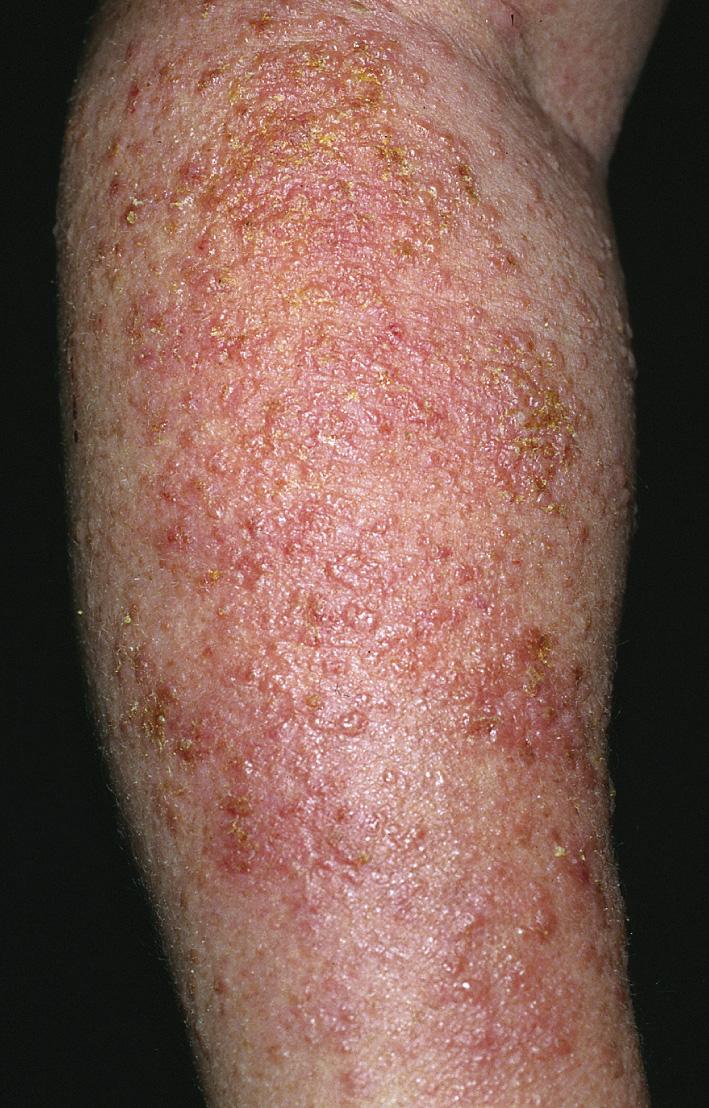
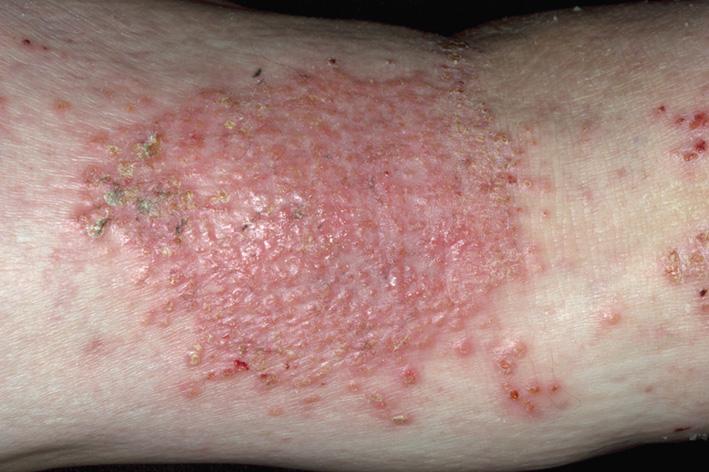
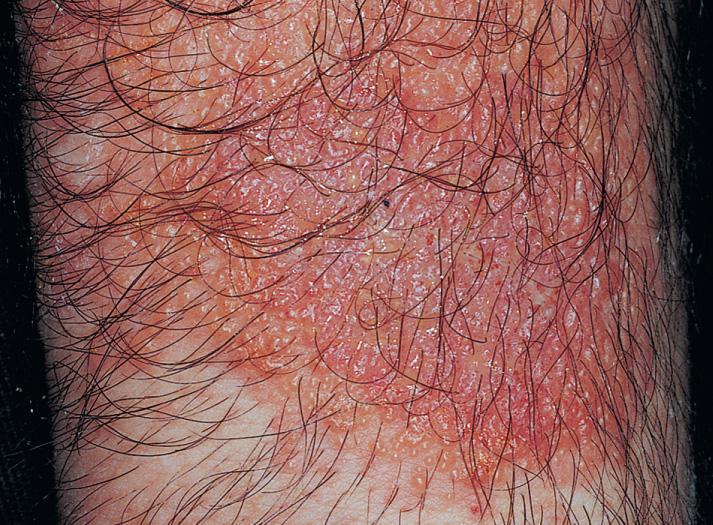
Oral antihistamines, such as diphenhydramine (Benadryl) and hydroxyzine (Atarax), can relieve itching, and their sedative effect may promote better sleep.
If secondary infection is suspected, an anti− Staphylococcus aureus antibiotic (e.g., cephalexin, dicloxacillin) is administered for 10 to 14 days.
Acute eczema may be confused with acute infections, such as cellulitis; the often marked itching associated with acute eczema should help distinguish them.
Repeated bouts of acute eczema on the face, exposed hands, or arms suggest a contact allergy that should be evaluated by patch testing. Scabies should be considered in new-onset eczema.
Remove all the patient's topical medications (lotions, topical over-the-counter medicaments, anti-itch preparations) and treat with topical steroids only, or with bland emollients—keep the skin care and exposures minimal and simple.
Elevation of the legs, if they are affected, is helpful in decreasing dependent edema and dermatitis.
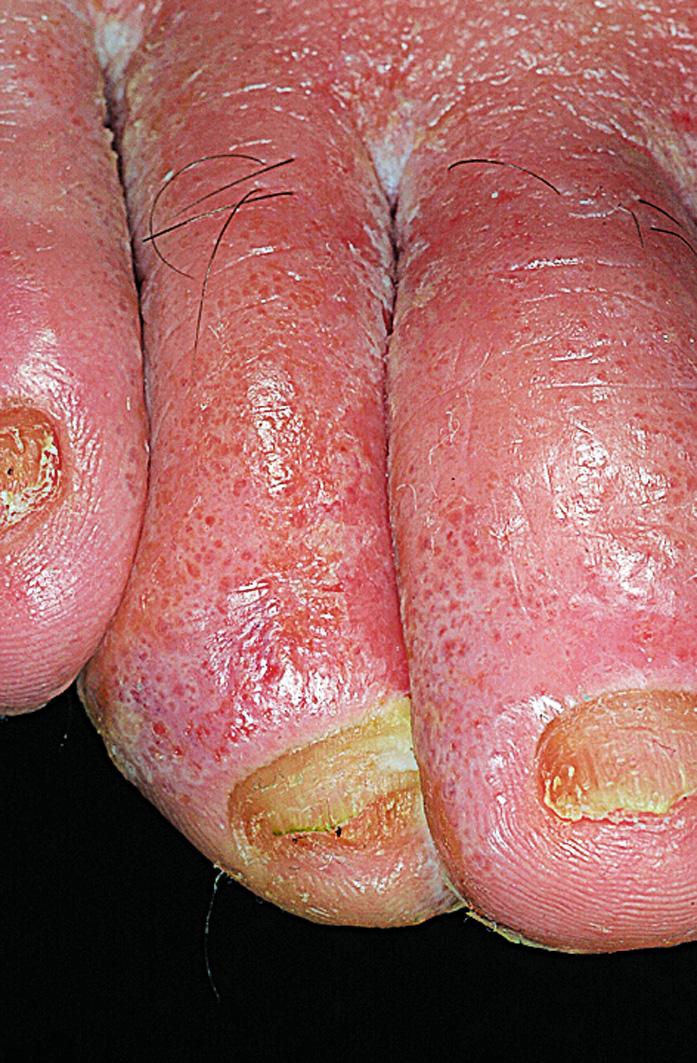
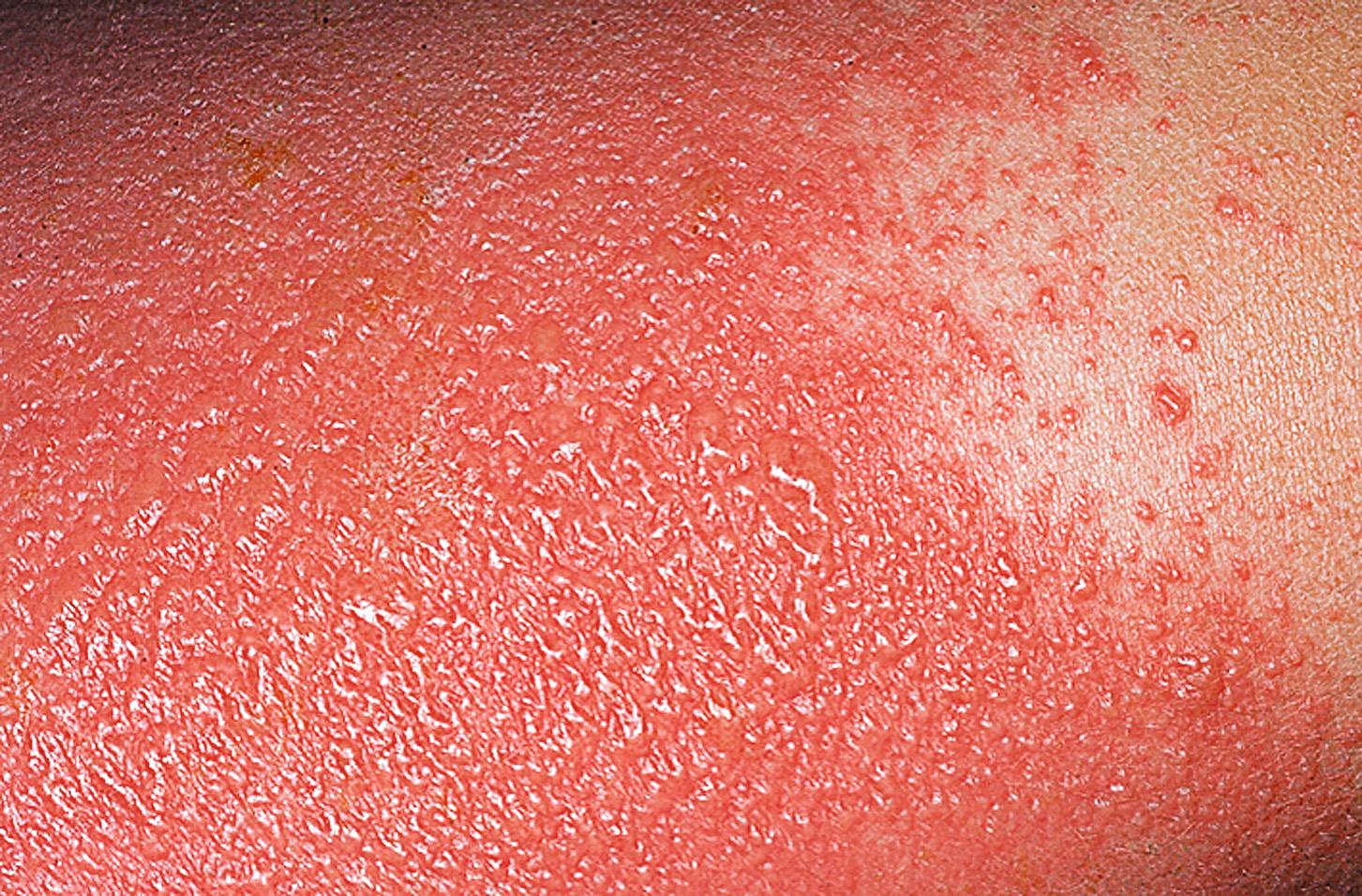
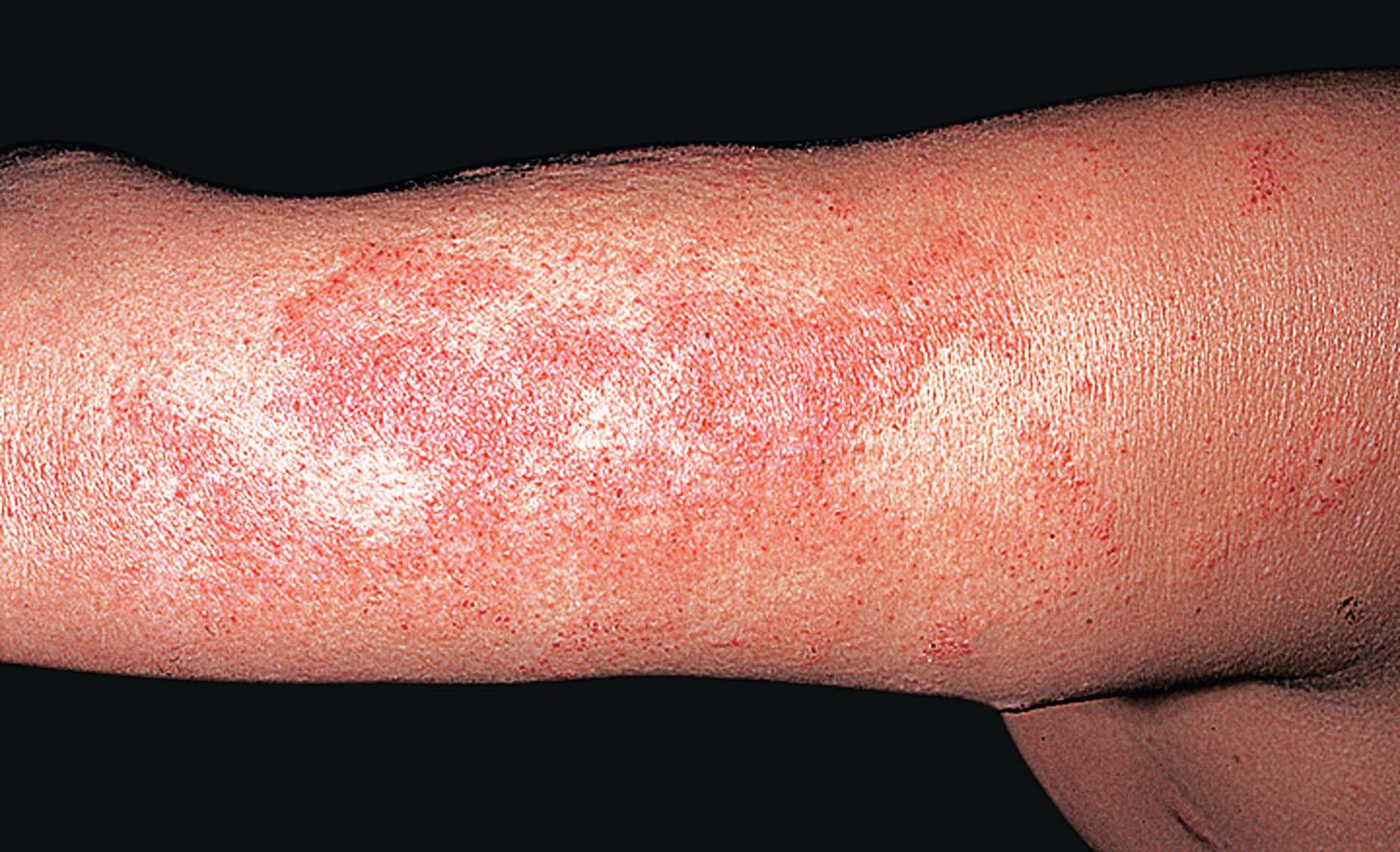
Poison ivy, poison oak, and poison sumac (plants of the Anacardiaceae family) and Toxicodendron species are the most common causes of allergic contact dermatitis in the United States; this problematic prototype of contact dermatitis is rarely reported in Europe, although related plants grow in Southeast Asia, Central America, and South America.
Oleoresin (lipid-soluble portion) contains a mixture of highly allergenic catechol chemicals called urushiols , a term derived from the Japanese word for sap, urushi .
Contact with the plant's leaf, stem, or root, even in autumn and winter, results in a pruritic bullous eruption within 8 to 72 hours of exposure in a previously sensitized individual and within 12 to 21 days in an individual who has not yet been sensitized (primary sensitization).
Primary sensitization can result from exposure to the allergenic plant. This process requires an intact immune system. After an individual has become allergic (sensitized), repeat exposure will cause the rash to occur more promptly (a process called elicitation ).
About half of American adults develop the rash if they are exposed; 30% to 40% require prolonged exposure to produce the dermatitis.
About 10% to 15% of Americans do not become sensitized (allergic).
Clinical findings vary with the quantity of oleoresin that contacts the skin, the pattern of contact, individual susceptibility, and regional variations in skin reactivity.
Findings include pruritic, edematous, linear erythematous streaks, usually with vesicles and large bullae on exposed skin.
Airborne particulate matter from burning the plant can result in intense, pruritic facial erythema and marked edema; the eyelids can be dramatically swollen.
Trauma to the skin from the plant may leave a temporary black mark on the skin—a clue to exposure and a result of dried and oxidized urushiol allergen.
The itchy eruption lasts from 10 days to as long as 3 weeks.
Short courses of oral corticosteroids (e.g., dose packs) are inadequate and may result in a rebound phenomenon with prompt blistering when discontinued.
The rash resolves completely without scarring.
Impetigo or cellulitis may occur from scratching and secondary bacterial infection (usually S. aureus ).
Short-term disability and time lost from work are significant occupational problems associated with this contact dermatitis, especially among firefighters, foresters, landscapers, and outdoor workers.
Poison ivy is not spread by blister fluid and is not spread from person to person.
The allergenic oleoresin can be spread by contaminated clothing, garden tools, or animals.
Cross-reacting allergens from other plants of the Anacardiaceae family include mango peel, the oil of raw cashew nut shells, Japanese lacquer, and ginkgo fruit pulp. Individuals sensitized to poison ivy may also react after exposure to these related plants.
Poison ivy grows as a shrub or climbing vine. In the United States, Eastern poison oak is typically found in the Southeast, whereas Western poison oak grows typically on the West Coast, in the form of a small shrub or tree. Poison sumac prefers a moist location and is common in peat bogs and wetlands of the eastern United States and southeastern Canada.
The skin should be washed with soap to inactivate and remove allergic oleoresin, thereby preventing further skin penetration and contamination. Washing is most effective if done within 15 minutes of exposure.
Exposed clothing and tools should be cleansed with soapy water.
Short, cool tub baths, with or without colloidal oatmeal (Aveeno), are soothing for itching and swelling.
Calamine lotion controls itching, but prolonged use can lead to excessive drying.
Oral antihistamines (hydroxyzine and diphenhydramine) may control itching. They are sedating and may be best used at night to reduce nighttime scratching and promote rest, thus offering relief from the stress of intense itch, which often interferes with sleep.
Cool, wet dressings made with tap water or Burow's solution are highly effective during the acute blistering stage. They are applied for 15 to 30 minutes several times a day for 1 to 4 days until blistering and severe itching are controlled. Cool, wet tap-water dressings are very useful for severe facial or eyelid edema.
A medium-potency topical steroid (groups II–V) should be generously applied after the wet dressing. If the periorbital skin is involved, a weaker topical steroid (groups VI–VII) is advised for a specified limited duration (twice daily for 7 days).
The immunomodulatory topical therapies, pimecrolimus (Elidel) and tacrolimus (Protopic), are not advised for acute allergic contact dermatitis to poison ivy, given their cost, the amount often required, and delay of efficacy compared with topical steroids.
A course of oral corticosteroids for severe, widespread inflammation is started at 0.5to 1 mg/kg/day and is slowly tapered over3 weeks.
A barrier cream, IvyBlock, contains quaternium-18 bentonite that can be successful in preventing the dermatitis or reducing the severity of reactions. However, it is essential that it be applied at least 15 minutes before anticipated exposure.
Poison ivy oleoresin in capsules and an injectable form for hyposensitization have been removed from the market as a result of side effects and incomplete efficacy. There are no means available currently for desensitization to poison ivy.
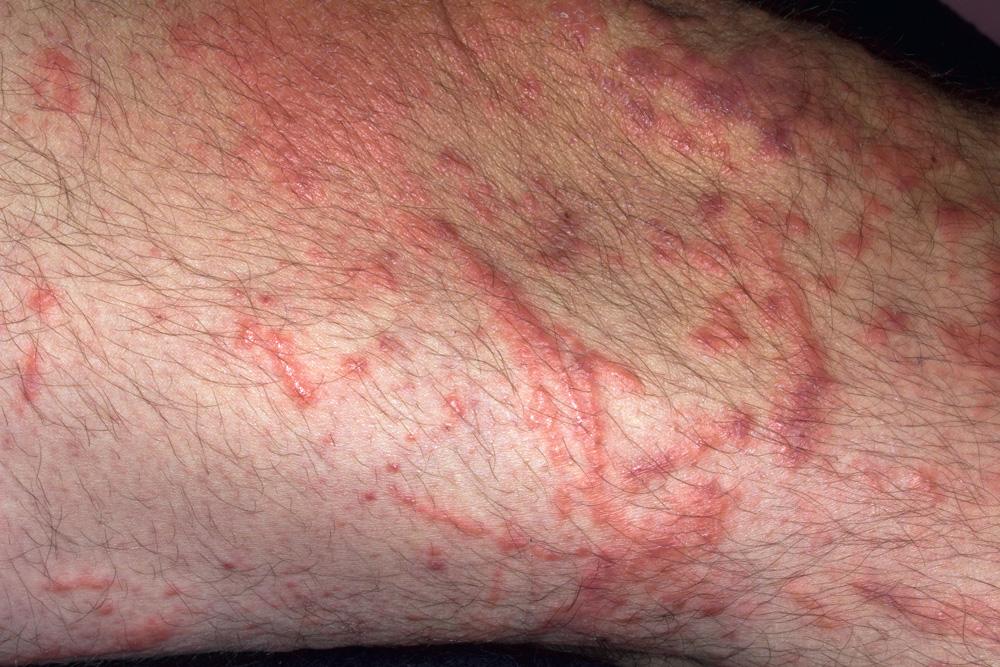
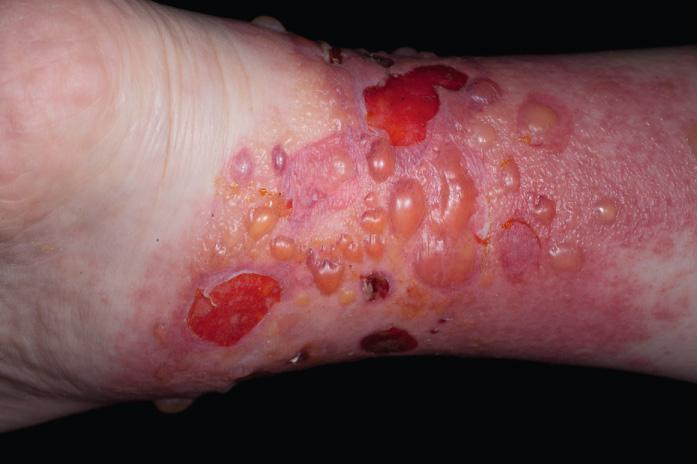
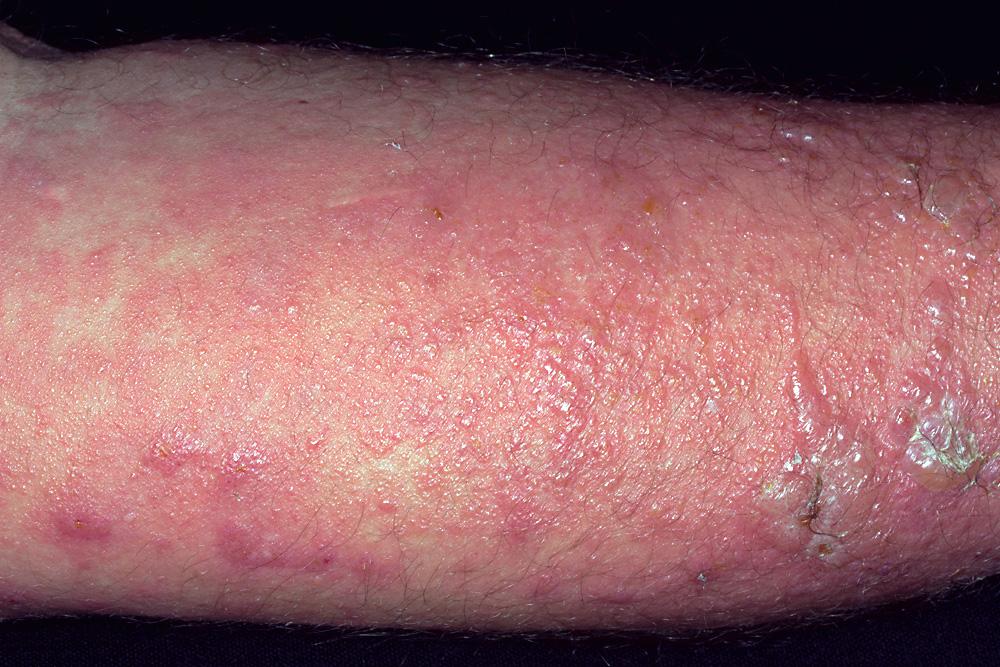
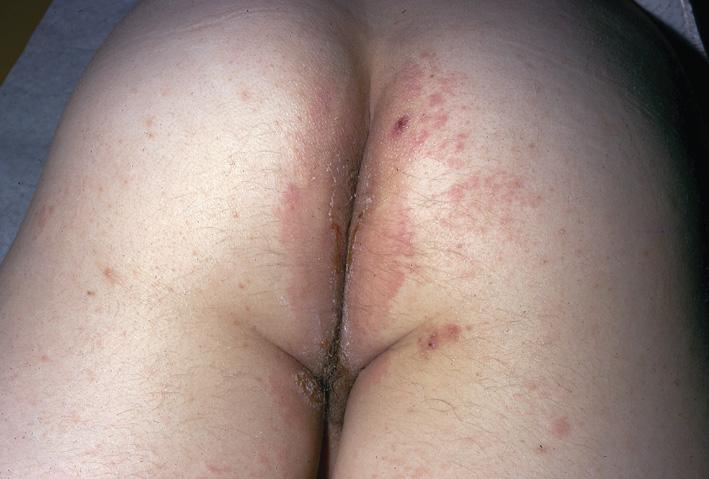
The classic presentation of poisonous plant contact dermatitis is variably sized vesicles and bullae appearing in a linear distribution on exposed skin.
Generally, repeated exposure over short periods of time (i.e., the summer months) results in increasingly severe bouts of the dermatitis.
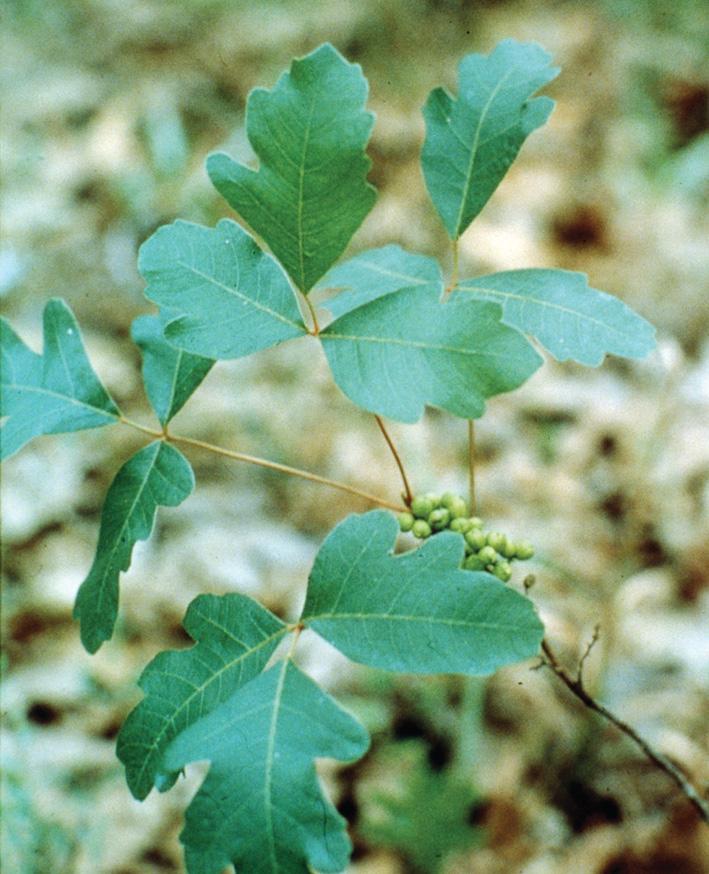
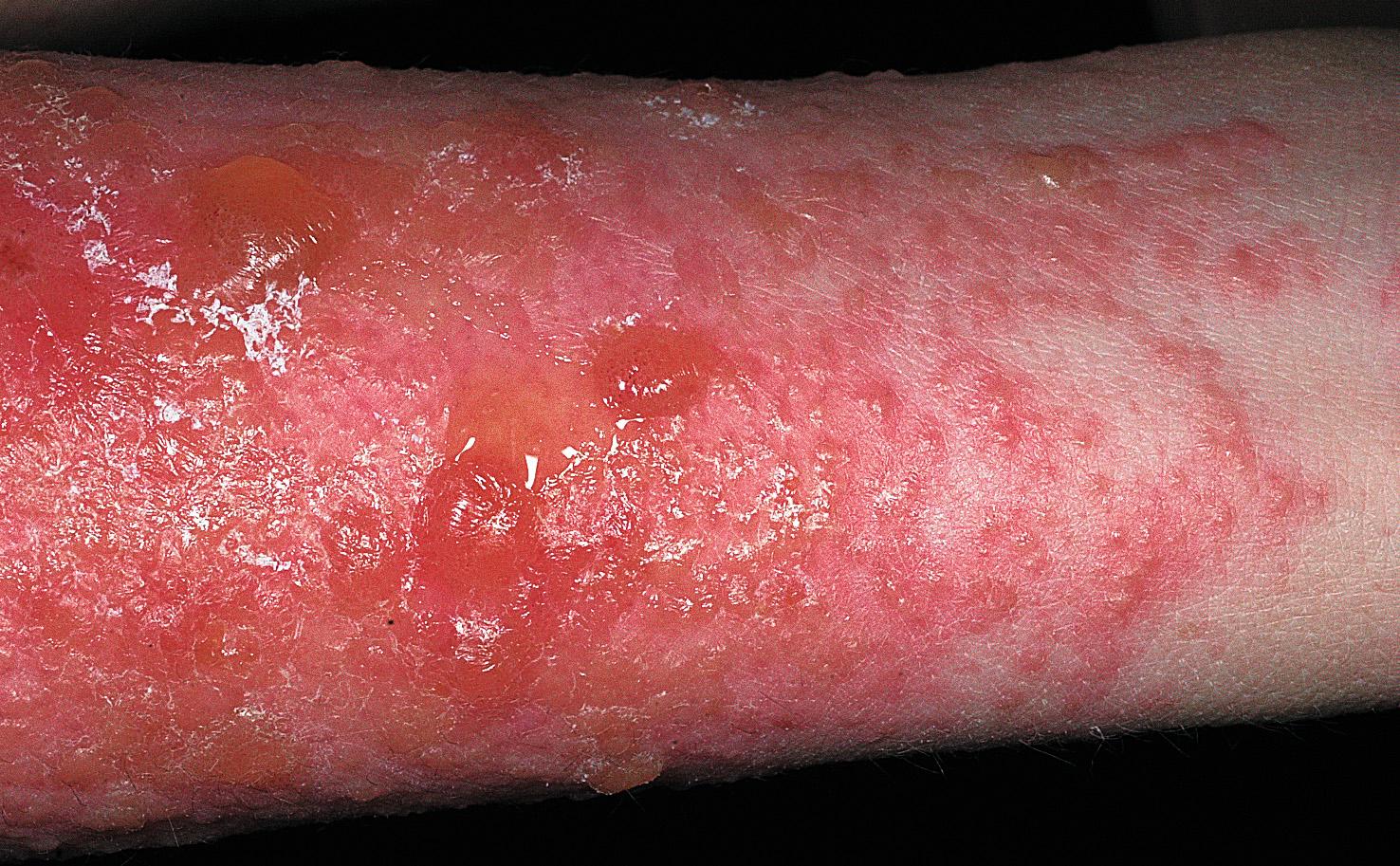
Oral ingestion of raw or incompletely roasted cashews can cause an internal–external reaction—a sudden erythematous pruritic dermatitis in a characteristic distribution on the buttocks, upper inner thighs, and axillary vault in individuals sensitized to urushiol.
Poison ivy, poison oak, or poison sumac can involve wide areas. The decision to use oral or topical steroids depends on the severity of the symptoms, age of the patient, and potential for short-term adverse reactions anticipated through review of the medical history.
Short courses of low-dose systemic corticosteroids are inadequate treatment for severe, generalized cases of poison ivy.
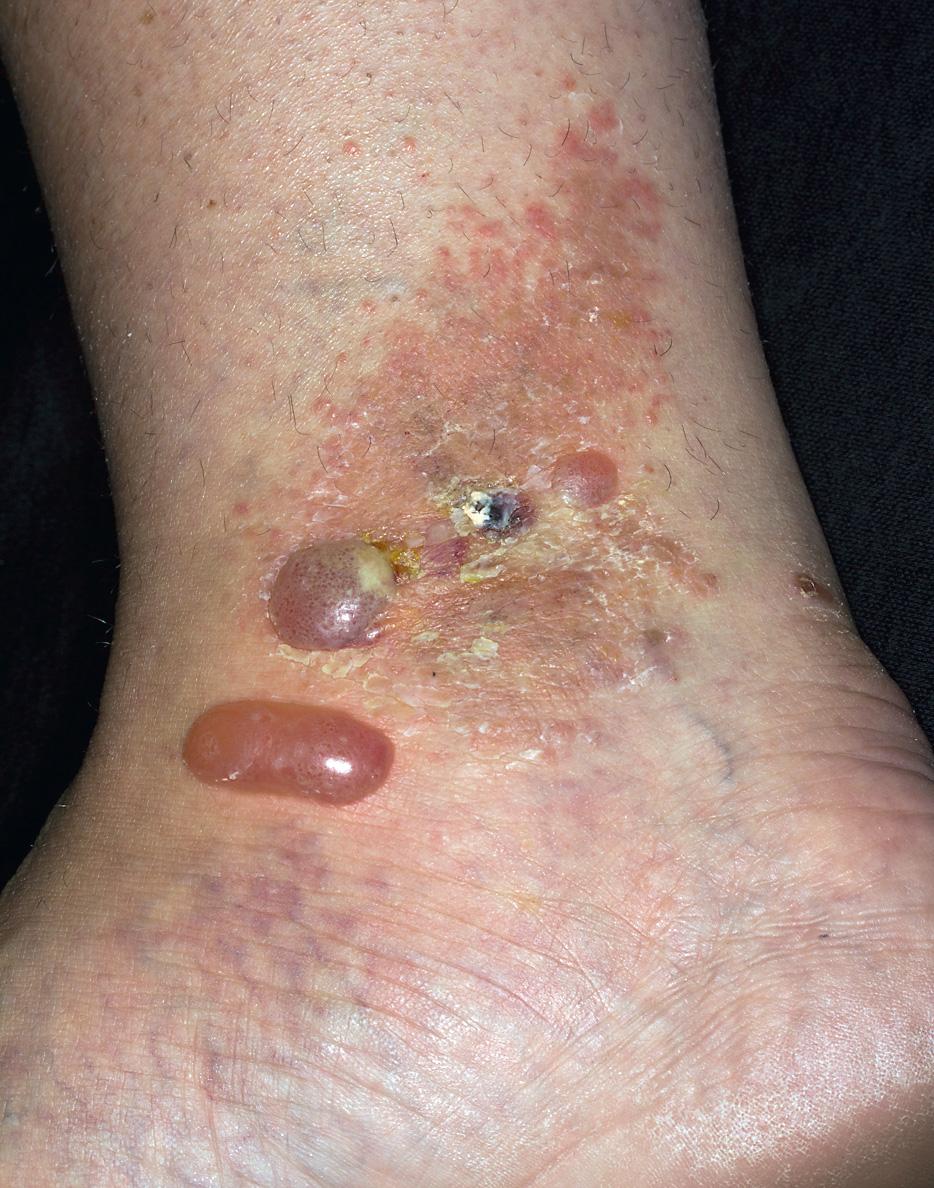
This eczematous inflammation consists of itchy, red, and scaling patches, papules, and plaques in various configurations.
This subacute condition may evolve from acute (vesicular) eczema.
This is the most common clinical manifestation of atopic dermatitis. It may also represent contact allergy.
Patients complain of dermatitis that has been present longer than 1 week.
Itching is variable; it can be moderate to severe or rather mild.
The condition resolves without scarring when provoking or contributing aggravating factors are removed. It may require treatment to resolve.
Excoriation and repeated exposure to aggravating conditions (water, detergents, irritants, or other common irritants or allergens) convert this condition to a chronic process.
Contact allergy, contact irritation, atopic dermatitis, scabies, stasis dermatitis, nummular eczema, fingertip eczema, and fungal infections may present as subacute eczema.
If there is not a strong atopic history, search for new cutaneous irritant or allergen exposures. Stress can aggravate and contribute to this problem but is not a common sole cause.
Groups II to V steroid creams twice a day with or without plastic occlusion are administered. Occlusion hastens resolution while increasing absorption of topical steroid. Duration of occlusion should be specified (2–8 hours) and limited (3–10 days).
Steroid ointments can be applied twice a day without occlusion.
Nonsteroid topical immune modulators tacrolimus (Protopic ointment 0.1, 0.03%) and pimecrolimus (Elidel cream 1%) can be applied twice daily to affected skin and are especially useful in subacute eczema of the face or periorbital eyelid skin. They may initially cause some stinging or burning of the skin, which subsides in a few days. These therapies are useful for chronic management of subacute eczema in atopic patients.
Tar ointments and creams (many over-the-counter preparations) provide an alternative for steroid-resistant lesions and are moderately effective in some patients.
Wet dressings should be avoided because they cause excessive dryness.
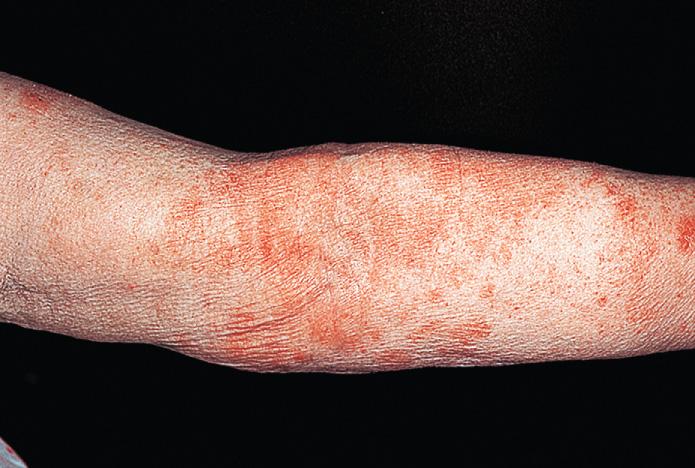
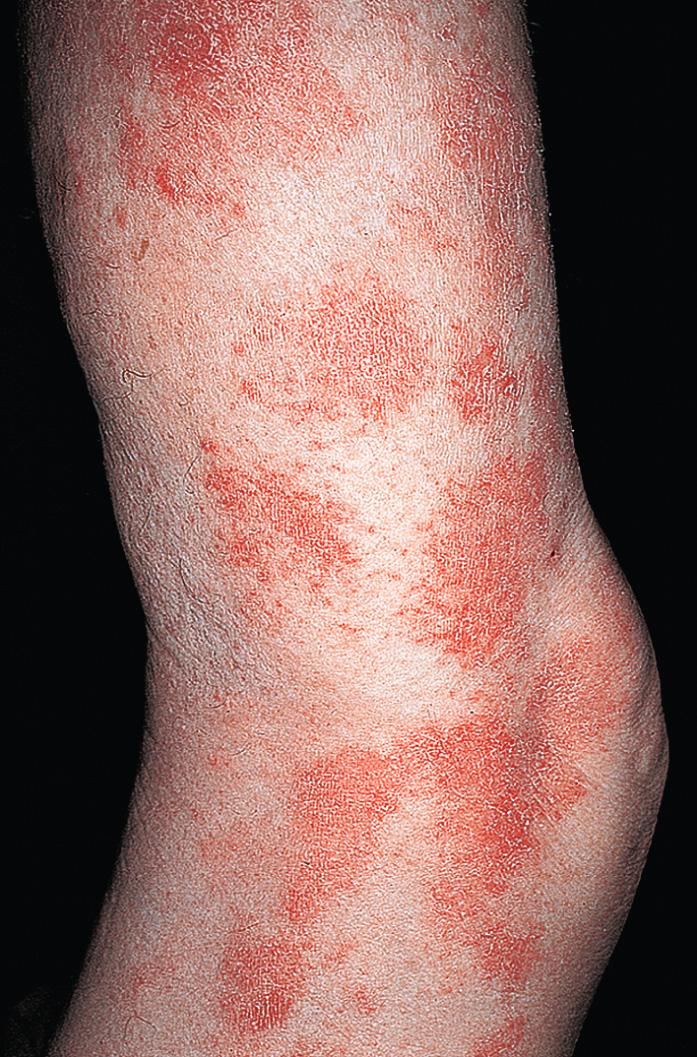
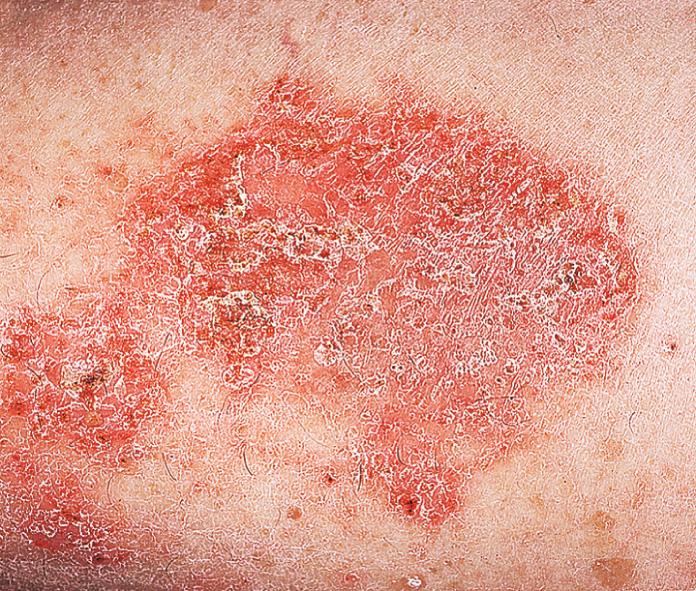
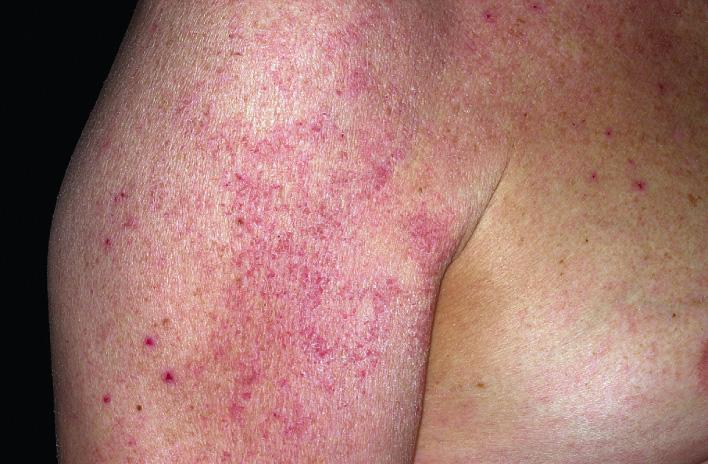
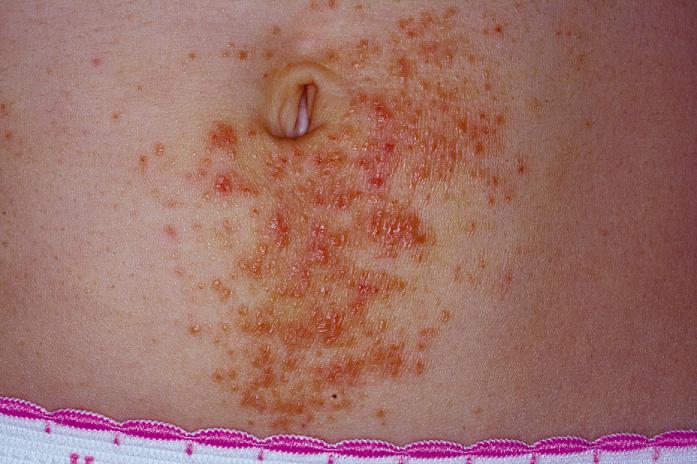
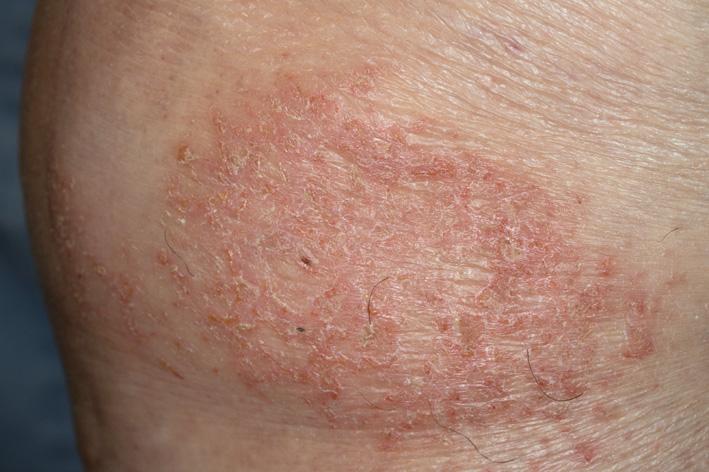
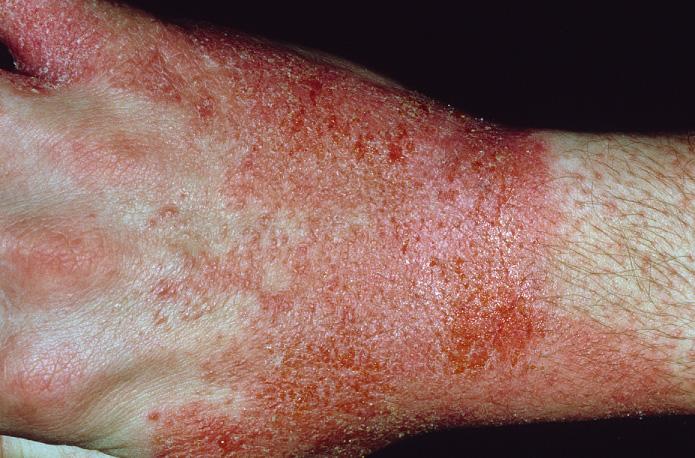
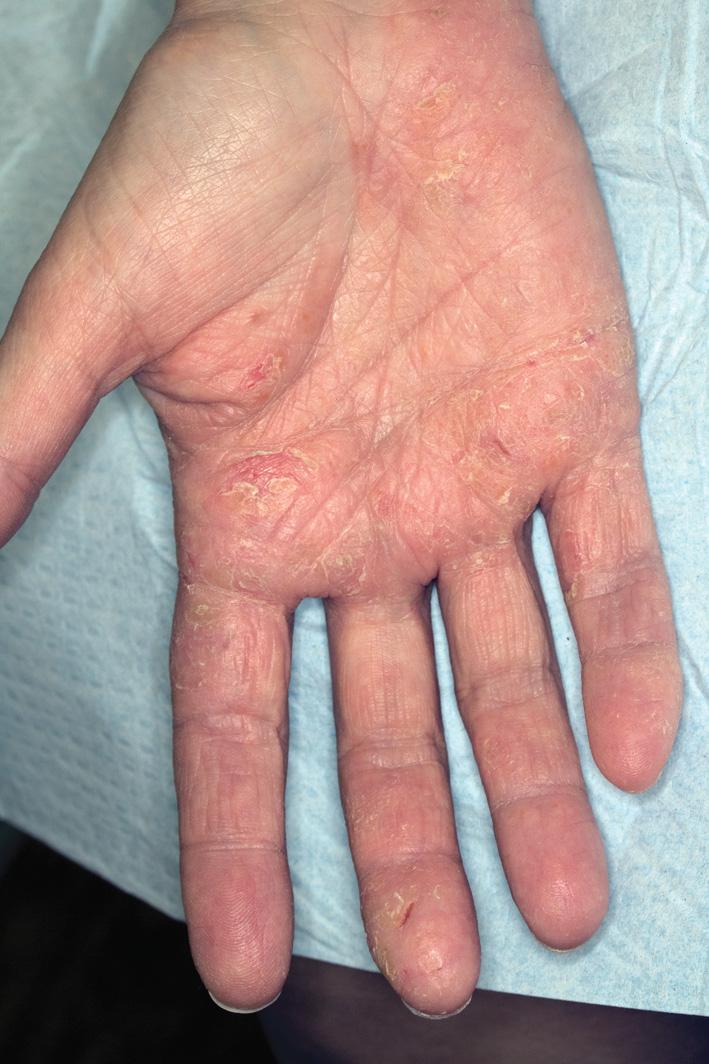
Moisturizers are an essential part of daily therapy.
Moisturizers work best when applied a few hours after topical steroids.
Application should continue for days or weeks after the inflammation has cleared.
Frequent application is encouraged.
Moisturizers are most effective when rubbed in well and applied directly after the skin is patted dry following a shower.
Creams with simple formulations lacking the most common allergy-associated ingredients (e.g., Vanicream, Aveeno, Cetaphil, DML, and CeraVe) are better than lotions. Plain petroleum jelly is an excellent moisturizer and has the advantage of being plain, without allergenic additives or irritating ingredients. Greasiness limits patient acceptability. Coconut oil is also an excellent moisturizer with low sensitization risk.
Infrequent washing with bar-type mild soap (e.g., Dove, Cetaphil, Keri, Purpose, and Basis) is also helpful.
Subacute eczema is a clinical manifestation of ongoing inflammation. Attention to cutaneous exposures of irritants, allergens, and the patient's overall skin care regimen is vital to addressing causes and aggravating factors.
Consider a potassium hydroxide examination of scale to rule out dermatophyte infection.
Ask about the patient's occupation, topical product use, house duties, and hobbies because they may contribute to ongoing skin irritation or risk for developing contact allergy. Vinyl gloves serve as a useful protective barrier if repeated exposure to water, irritants, or allergens is occurring. Vinyl gloves are a good choice because they do not contain common rubber-related allergens (gloves can be ordered online from http://www.allerderm.com ).
Affected skin is inflamed, red, scaling, and thickened (lichenified).
There is moderate to intense, prolonged itching.
Scratching and rubbing become habitual and may be done subconsciously.
The disease becomes self-perpetuating. It often is frustrating and emotionally exhausting for the patient.
Scratching leads to thick skin, which itches even more.
Intense itching can lead to excoriations.
Inflamed, itchy skin thickens, and surface skin markings become more prominent.
Thick plaques with deep parallel skin markings appear (lichenification).
Sites commonly involved are those easily reached or creased areas.
Common locations are the back of the neck, popliteal fossae, ankles, eyelids, and anogenital skin.
Hyperpigmentation or hypopigmentation can occur on affected skin.
Atopic dermatitis, chronic allergic or irritant contact dermatitis, habitual scratching, scabies, lichen simplex chronicus, chapped and fissured feet, nummular eczema, asteatotic eczema, fingertip eczema, and hyperkeratotic eczema are possible etiologies. Cutaneous T-cell lymphoma should be considered and may need to be excluded by multiple biopsies and molecular studies.
The evolution of this process is the result of a chronic process.
Chronic eczematous inflammation is often resistant to treatment; the key to success is breaking the itch–scratch cycle through treatment and removal of the cause or sources of aggravation, including delayed type hypersensitivity allergens which can be identified by patch testing.
A cool, wet dressing on the affected skin for 20 minutes will help soothe and diminish itch; it can be very helpful for the nighttime itch urge. It should be followed by emollient use or topical steroid application.
Group I or II creams or ointments applied twice a day can be effective.
Groups II to V steroids are used with plastic occlusion for 2 to 8 hours.
Intralesional injections (e.g., Kenalog diluted to 2.5–5 mg/mL) are very effective; resistant plaques are reinjected at 3- to 4-week intervals. Atrophy is a possible adverse effect.
Steroid-impregnated tape (e.g., Cordon tape) should be left on for 12 hours.
Steroid sparing agents including mycophenolate mofetil, azathioprine, methotrexate, and cyclosporine have all been used in the treatment of chronic eczema. Newly approved dupilumab is a major advance in therapy for chronic, severe eczema. It is administered every two weeks.
Chronic rubbing or scratching is at least part of the problem—address it and aim to diminish it.
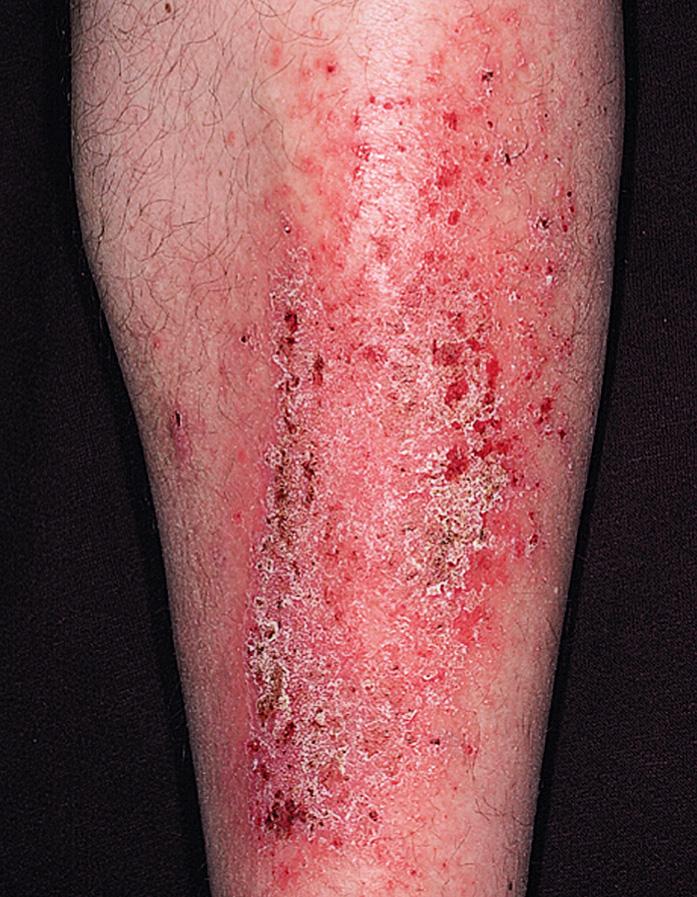
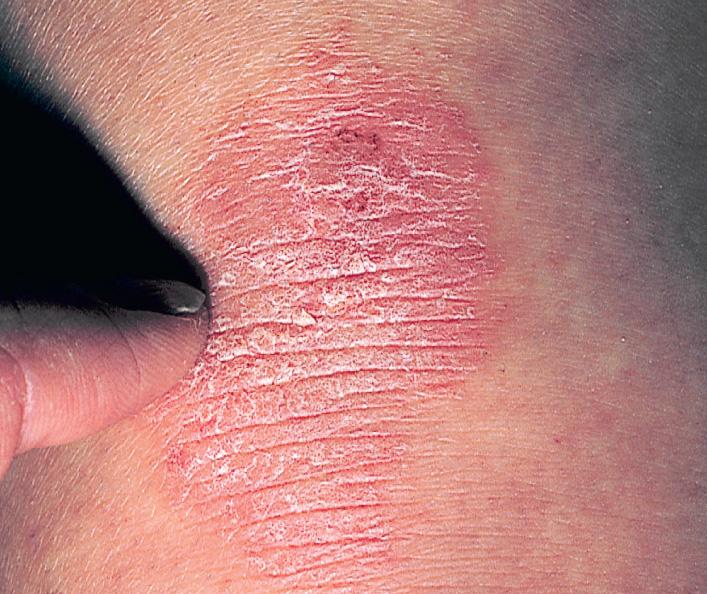
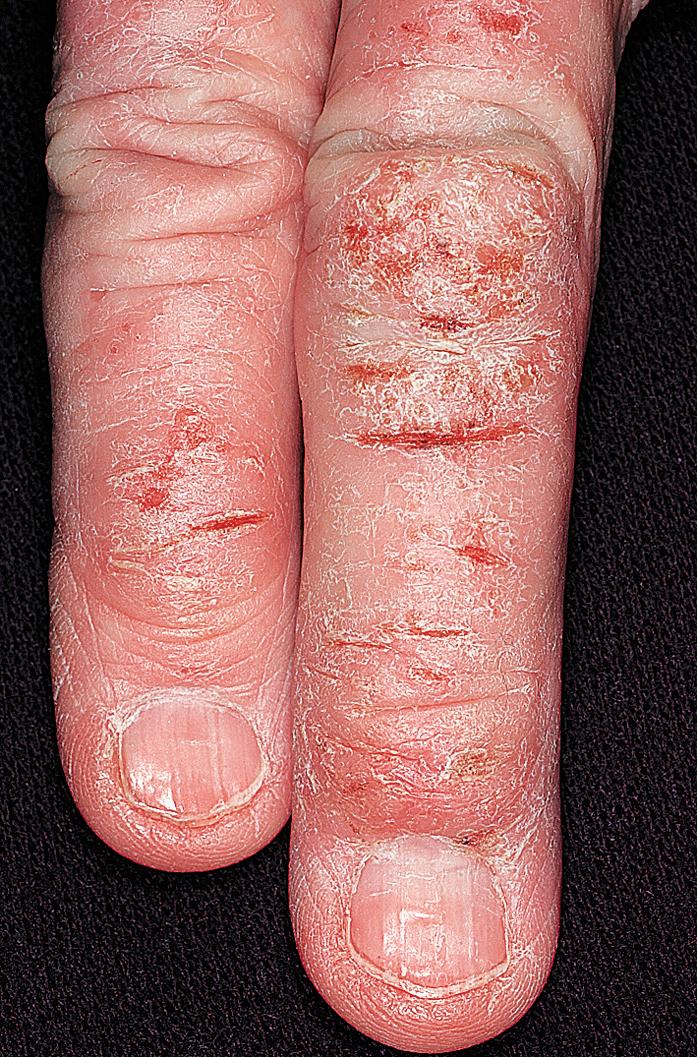
Ointments penetrate lichenified skin well and are generally more effective than creams on lichenified skin.
Consider and evaluate for contact irritants and allergens. Patch test to evaluate for contact allergy. Simplify the skin regimen: mild soaps, bland emollients (petrolatum, Vanicream, CeraVe, or Cetaphil) only.
Protopic ointment (tacrolimus) can be helpful for involved lichenified chronic eczema on the face.
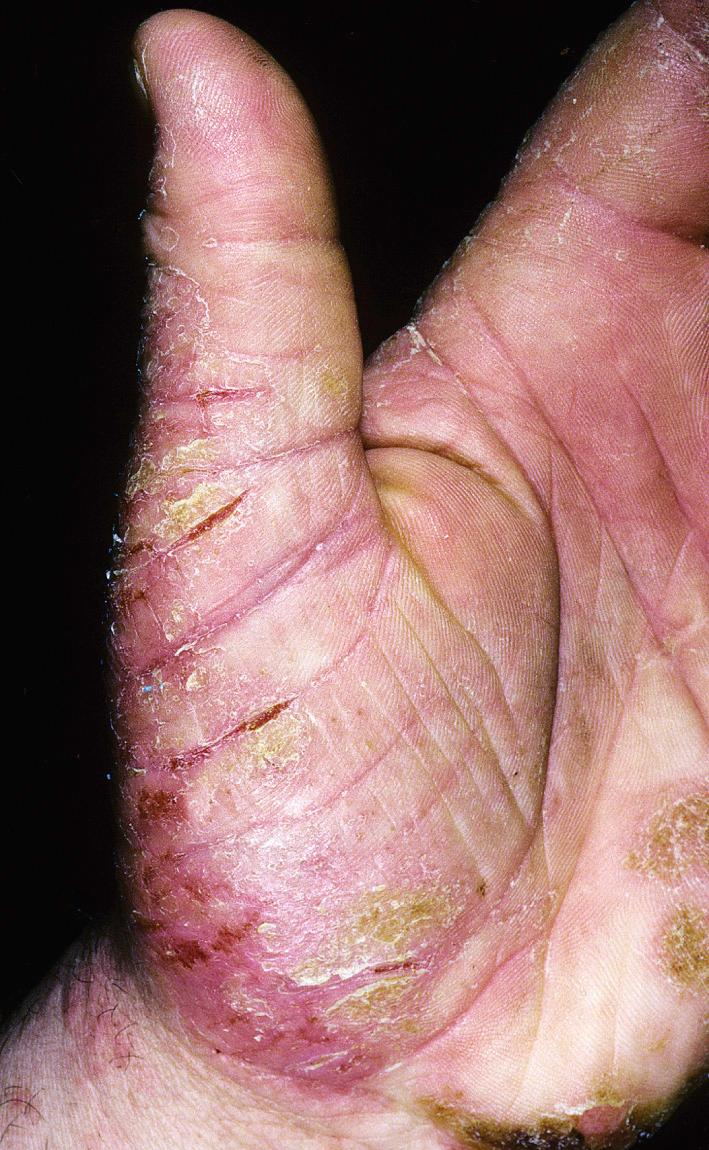
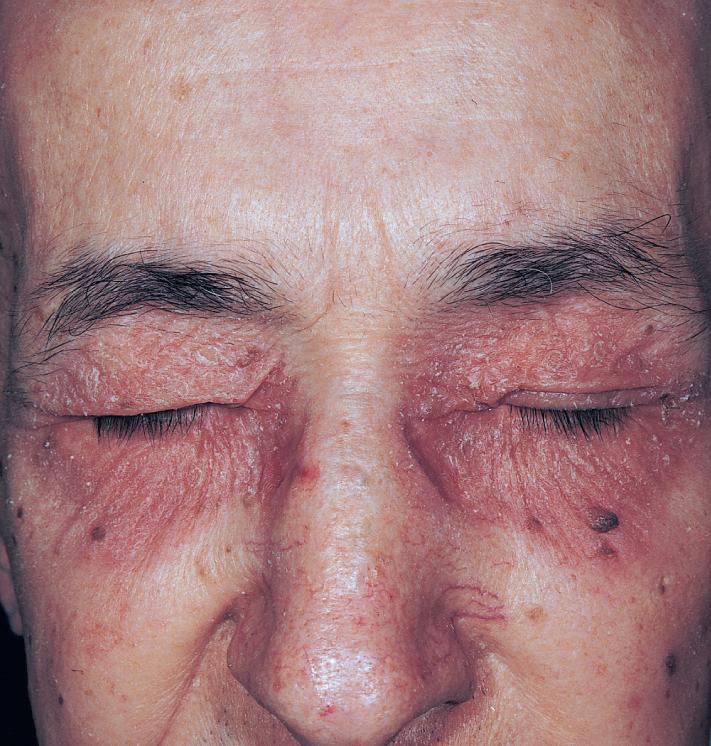
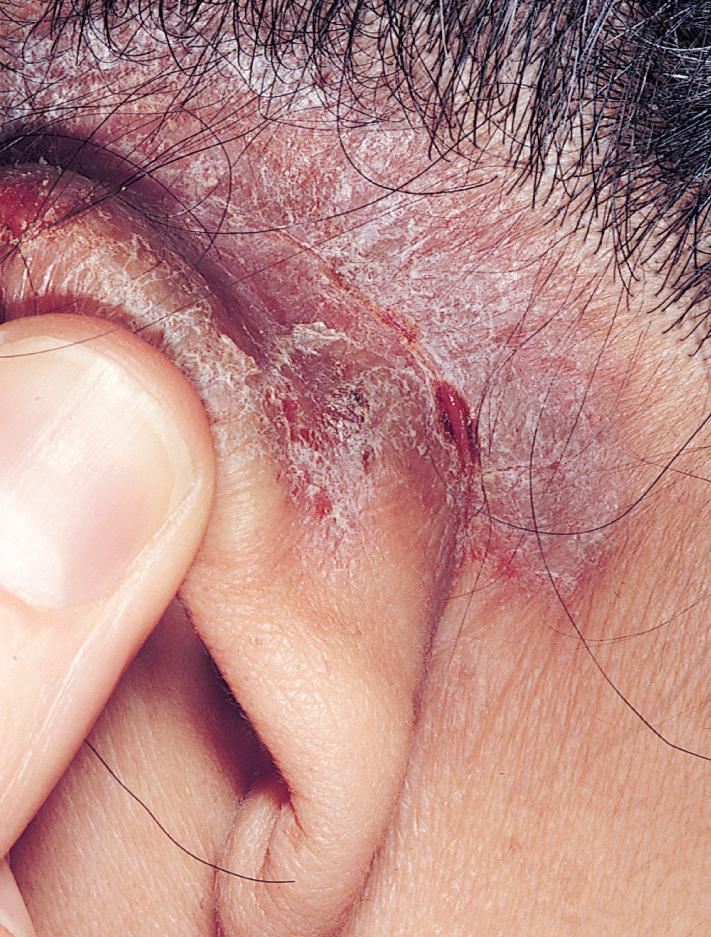
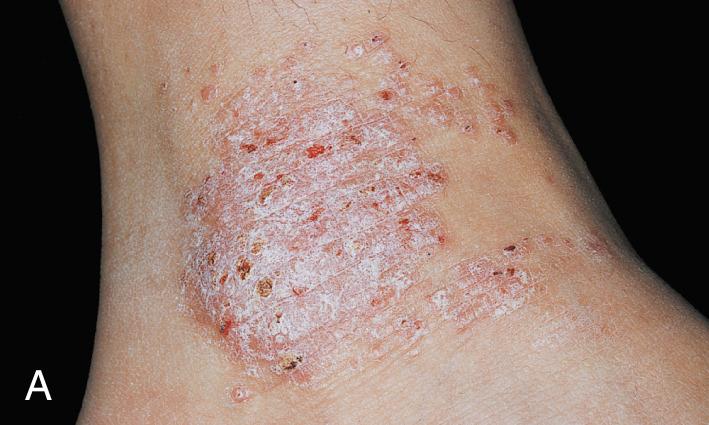
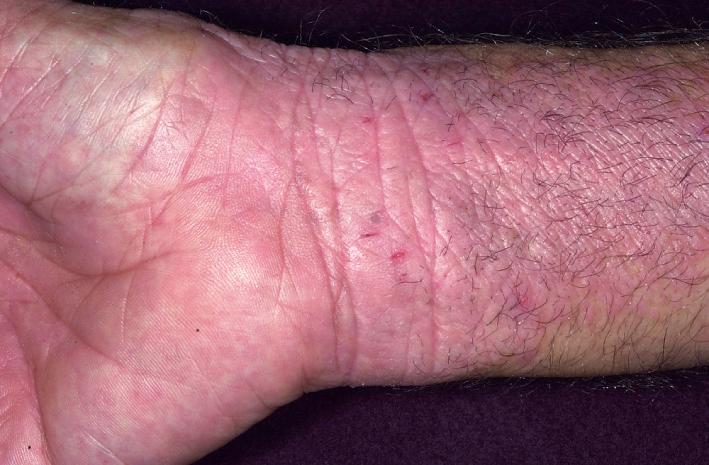
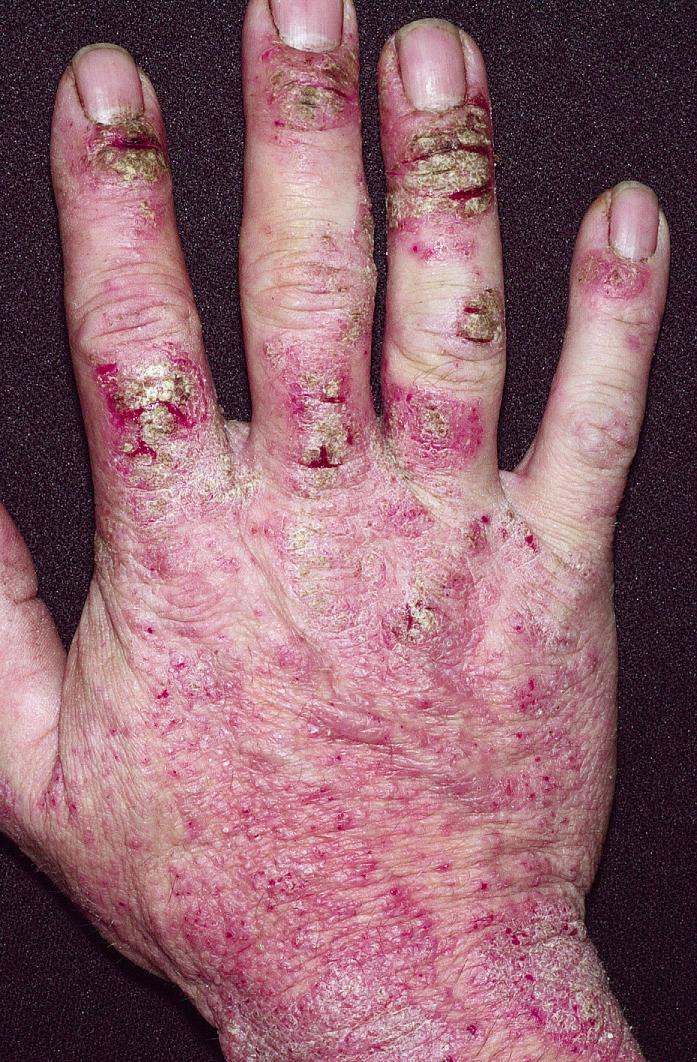
A localized plaque of chronic eczematous inflammation is created by habitual rubbing and scratching.
The affected skin is frequently located on the wrists, ankles, anogenital skin, and back of the neck.
This condition is more common in adults but may be seen in atopic children.
Findings include a sharply demarcated, deeply violaceous colored or red scaly plaque with prominent skin lines (lichenification).
Although this is a chronic eczematous disease, acute changes of vesiculation and weeping may result from sudden allergy to topical treatments.
Moist scaling, serum, crust, and pustules signal secondary infection.
Nodules, usually smaller than 1 cm and scattered randomly in the scalp, occur in patients who frequently pick at the scalp.
The areas most commonly affected are conveniently reached; these areas include the outer portion of the lower legs, wrists and ankles, posterior neck, scalp, upper eyelids, the fold behind the ear, scrotum, vulva, and anal skin.
A potassium hydroxide scraping should be considered to look for tinea. Tinea infection can mimic lichen simplex chronicus.
A contact allergy may cause, lead to, or complicate lichen simplex chronicus. Patch testing to identify the role of allergens can be helpful.
A typical plaque stays localized and shows little tendency to enlarge with time. After established, the plaque does not usually increase in size.
Stress may play a role in some individuals and should be acknowledged and addressed.
The patient should understand that the rash does not resolve until even minor scratching and rubbing are stopped. Education and patient behavior insight are critical.
Scratching frequently takes place during sleep, and the affected area may have to be covered.
Treatment consists of a 5-minute water soak followed by the application of a topical steroid with medium-to-high potency in an ointment base.
The treatment of the anal area, genitalia, or fold behind the ear does not usually require the administration of potent topical steroids; rather, these areas should be treated with low-potency topical steroids in an ointment base.
For scalp lesions, a group I or II steroid gel, such as fluocinonide (Lidex), or a solution, such as clobetasol (Cormax scalp solution) or betamethasone dipropionate lotion (Diprolene), is applied twice each day.
Moist, secondarily infected areas respond to oral antibiotics and a topical steroid lotion.
Grenz ray (superficial x-ray) therapy can be helpful but has limited availability.
Nodules caused by picking at the scalp may be very resistant to treatment, requiring monthly intralesional injections with triamcinolone acetonide (Kenalog diluted to 2.5–5 mg/mL).
This condition was once referred to as localized neurodermatitis .
The patient can derive great pleasure from scratching to relieve the inflamed site. Loss of pleasurable sensation or continued subconscious habitual scratching may explain why this eruption frequently recurs.
Lichen simplex chronicus affecting the genitalia or anus can be a very chronic, difficult problem causing considerable distress and frustration.
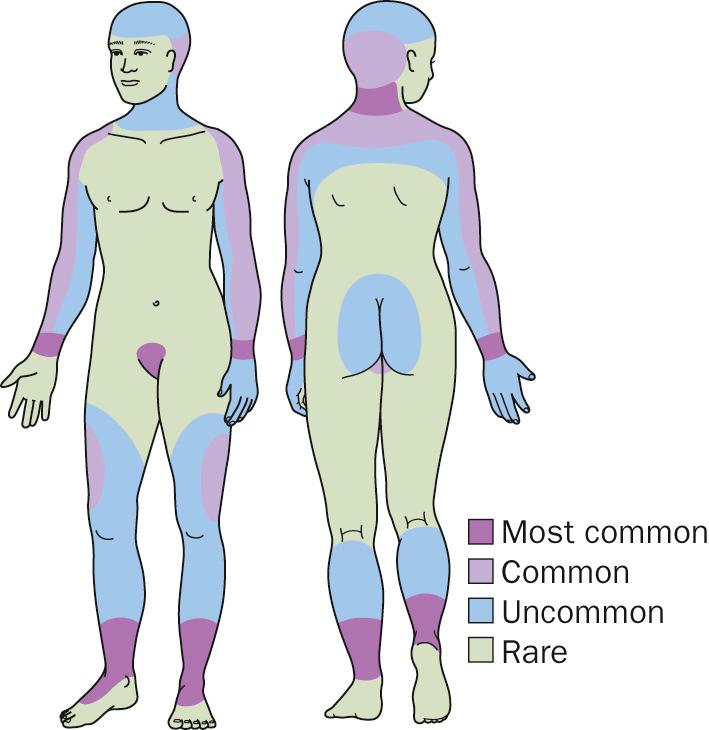
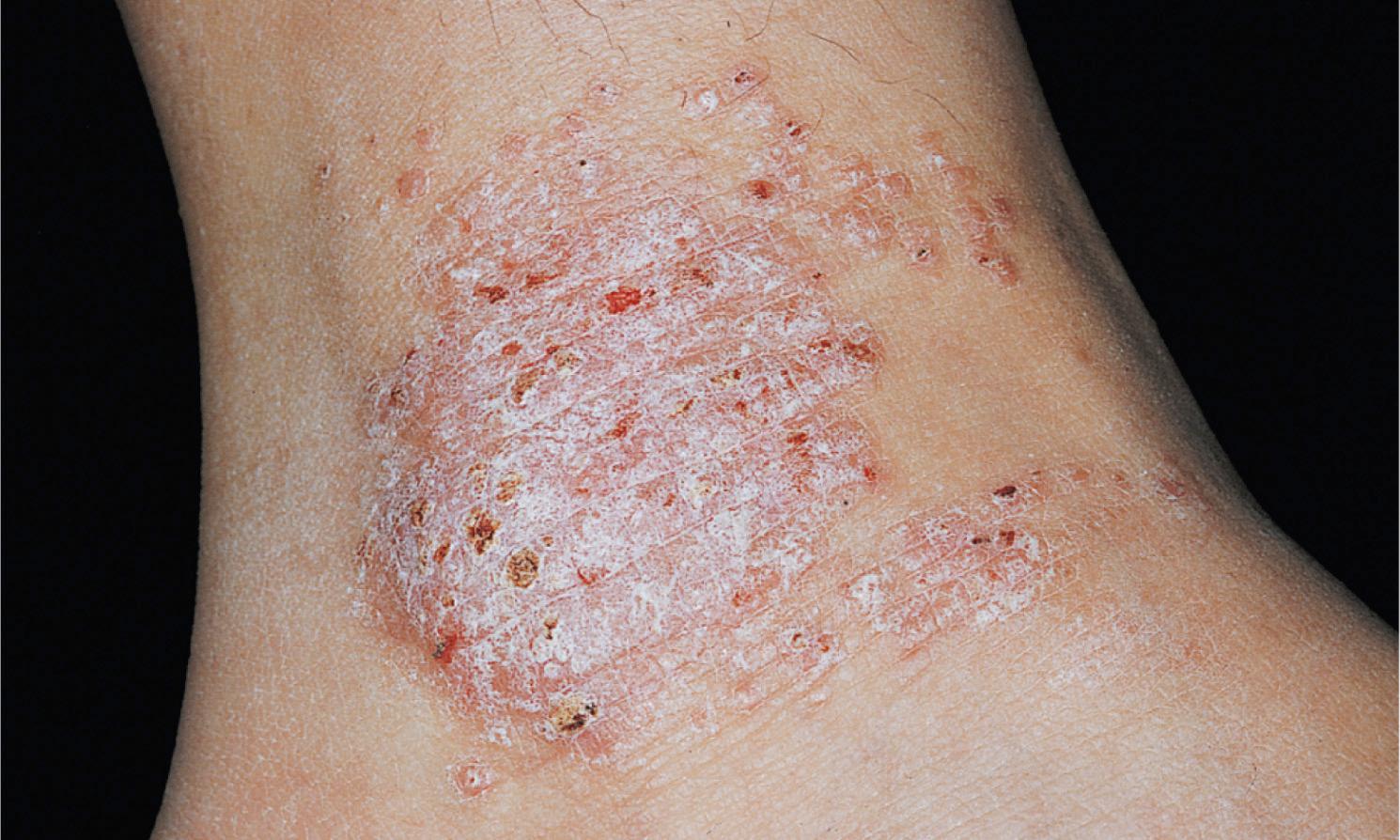
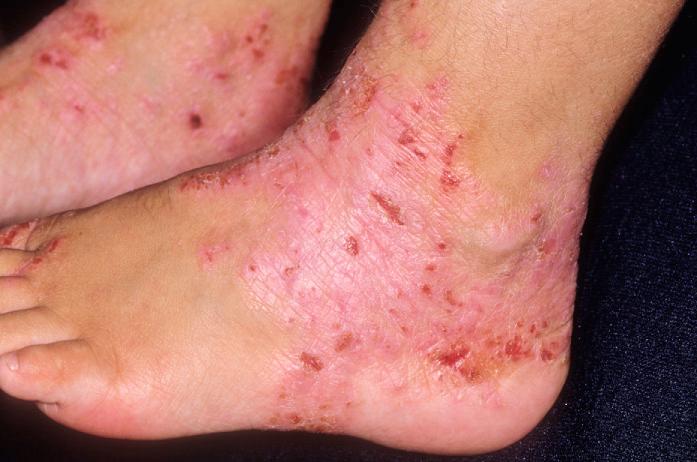
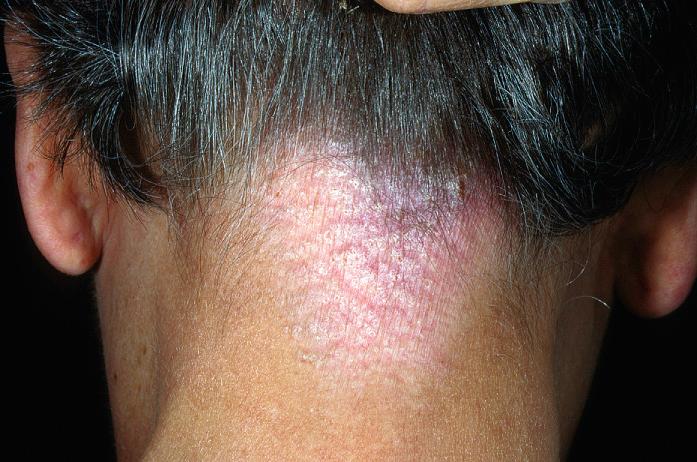
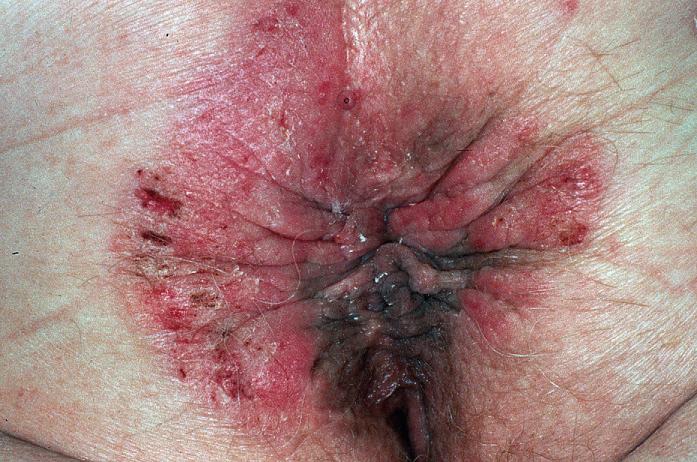
The occipital scalp is possibly the most common target for anxiety-induced scratching. Very thick plaques may form that are difficult to manage, and sometimes they become infected.
Although stress does not cause this condition, it most definitely contributes to aggravating and perpetuating it. Ask about stress, address the role it can play, and seek avenues for stress reduction.
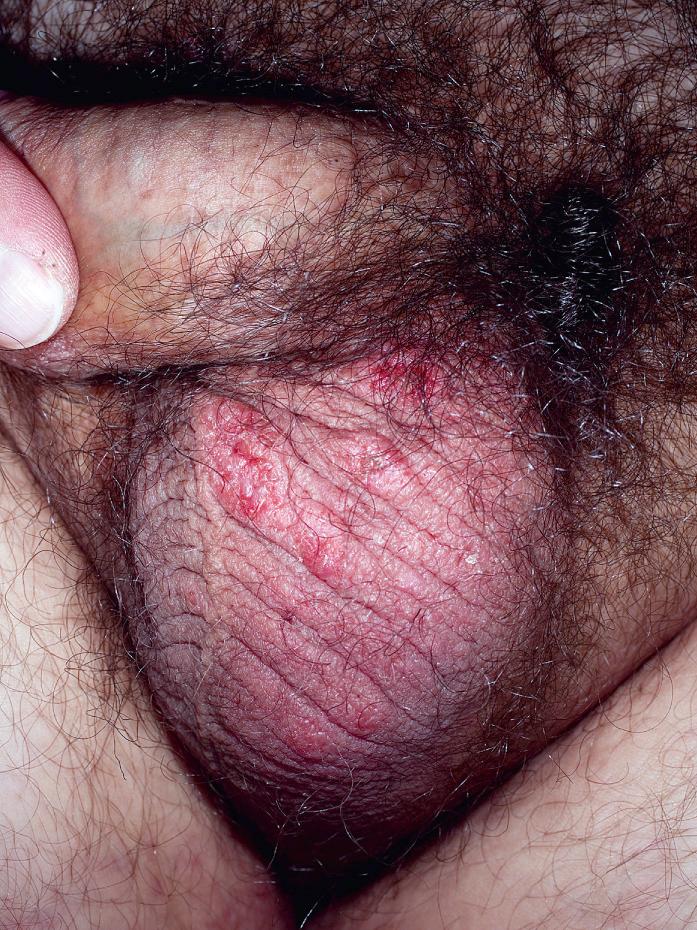
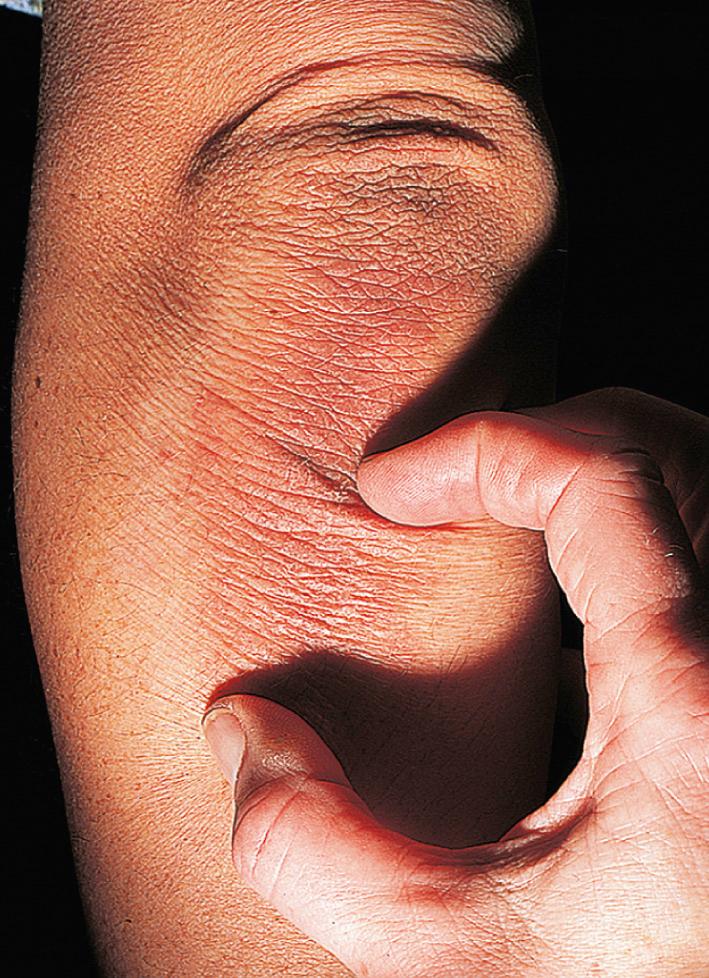
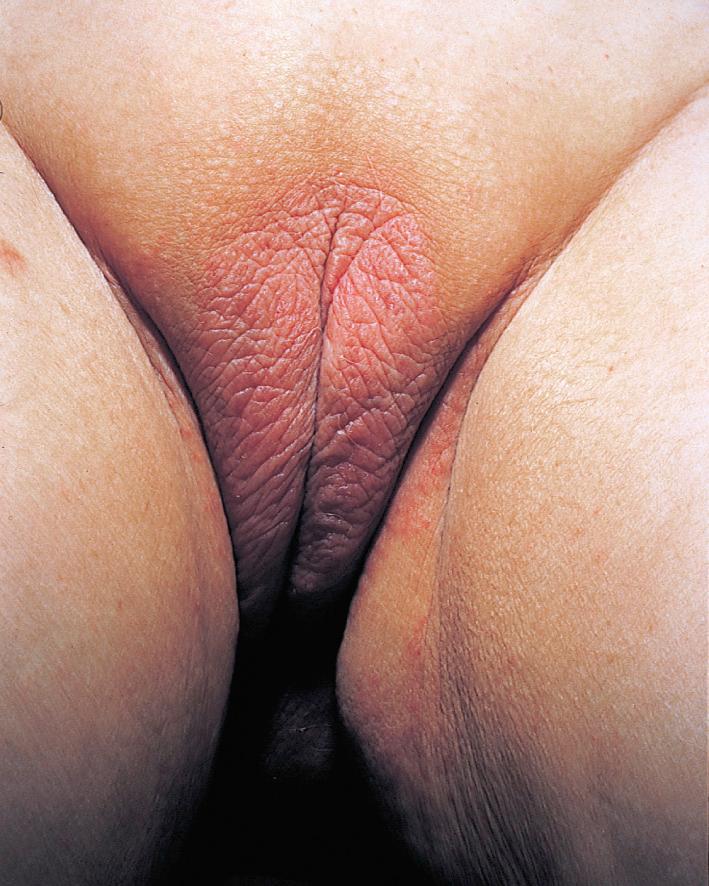
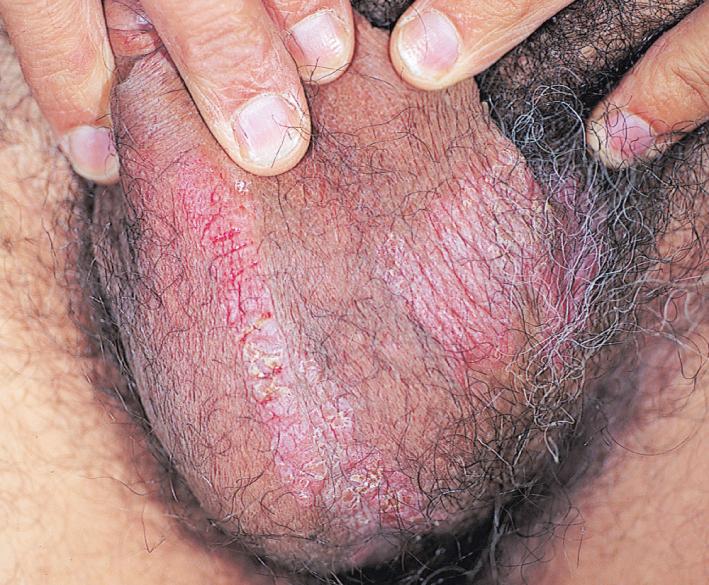
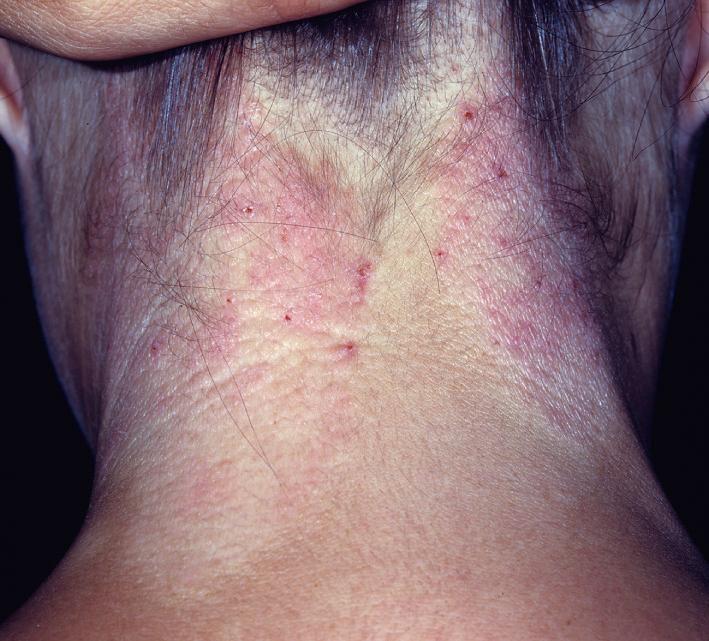
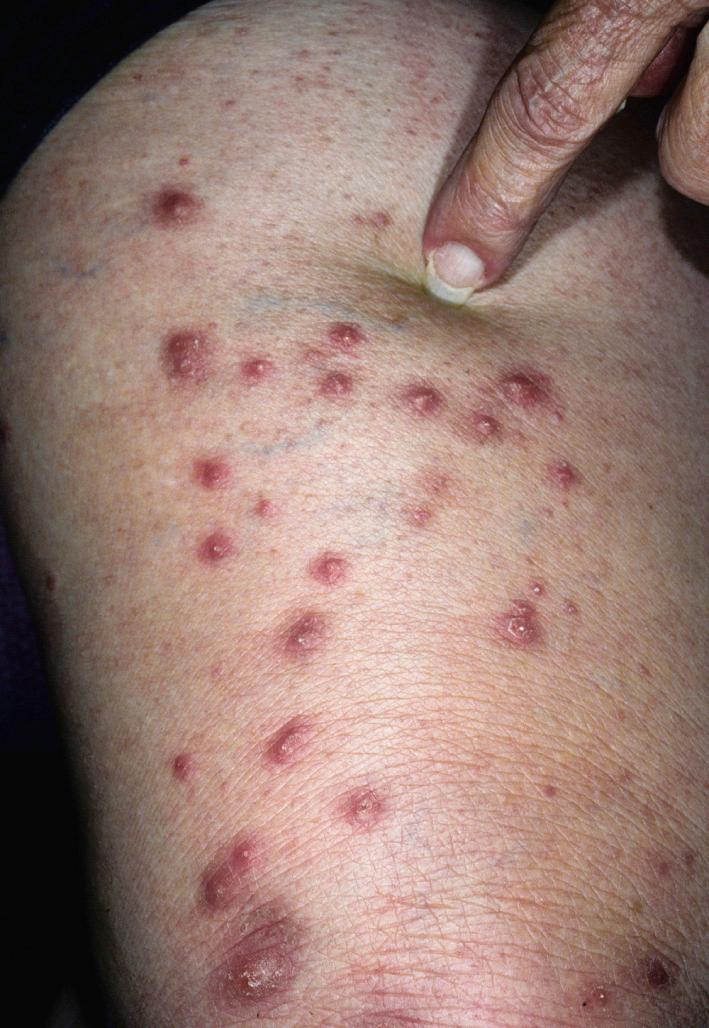
Nighttime itching can be diminished with this routine: oral antihistamines, such as diphenhydramine (Benadryl) or hydroxyzine (Atarax); followed by a 20-minute cold wet tap-water dressing; followed by application of a topical steroid to the affected skin.
Consider patch testing for lichen simplex chronicus affecting the periorbital skin, the dorsal hands or feet, or the anogenital skin.
Compliance is important to resolution of this problem. Take time and be specific in the explanation of your goals and treatment.
Areas most commonly affected are listed in approximate order of frequency:
Outer lower portion of lower leg
Scrotum, vulva, anal area, and pubis
Wrists and ankles
Upper eyelids
Back (lichen simplex nuchae) and side of neck
Orifice of the ear
Extensor forearms near elbow
Fold behind the ear
Scalp-picker's nodules
Hand eczema is a common, often chronic problem with multiple causative and contributing factors.
Hand eczema can be categorized as follows: irritant; keratolysis exfoliativa; atopic; fingertip; allergic; hyperkeratotic; nummular; pompholyx (dyshidrosis); lichen simplex chronicus; and id reaction. Each of these types of hand eczema is covered separately elsewhere in this book.
Irritant hand eczema is most common, followed by atopic hand eczema.
Allergic contact dermatitis accounts for 10% to 25% of hand eczema.
Women are affected more often than men.
Occupational risks include irritant chemical exposure, frequent wet work, chronic friction, and work with sensitizing (allergenic) chemicals.
Irritants include chemical irritants (e.g., solvents, detergents, alkalis, and acids), friction, cold air, and low humidity.
Allergens include occupational and nonoccupational sources. Immediate type I hypersensitivity reaction can involve reactions to latex and food proteins, and the more common delayed-type (type IV) hypersensitivity reaction can involve reactions to rubber additives, nickel, medicaments (bacitracin, neomycin, and hydrocortisone) and commonly found chemical ingredients in personal care products or cleaning products (e.g., preservatives, fragrances, sunscreen, and other additives). Ingested allergens (e.g., nickel) may play a role.
Infection can involve id reactions, including hand eczema as a reaction to a distant focus of fungal (i.e., dermatophytid) or bacterial (i.e., bacterid) infection.
Atopic diathesis (hay fever, asthma, atopic eczema) is often a predisposing factor and may contribute to susceptibility to the disease and chronicity of the problem, despite appropriate treatment and care measures.
The entire skin should be examined for clues and contributing factors and for exclusion of other dermatoses (i.e., psoriasis, cutaneous lymphoma, connective tissue processes).
This condition is variable; acute, subacute, and chronic eczematous changes may be seen. Although there is no reliable association between clinical pattern and etiology, the following findings may prove useful:
Xerosis, erythema, burning more than itching on dorsal or volar hands: irritant factors should be suspected.
Nummular eczema, dorsal hands and fingers: allergy, irritation, or atopy can play a role—occasionally, contact urticaria (type I hypersensitivity reaction) is the culprit.
Recurrent crops of intensely pruritic vesicles on lateral fingers and palms: pompholyx, otherwise called dyshidrotic eczema, should be suspected. Consider patch testing.
Fingertip eczema (dryness, splitting, tenderness, no itch): an irritant, an endogenous factor (atopy during the winter), or frictional eczema should be suspected.
Erythema, scaling, itching, in the “apron” (base of the fingers) area of palm: atopy should be suspected.
Atopic patients may have a personal or family history of atopy, including eczema in childhood, hay fever, or asthma.
If exposures to irritants and allergens can be identified and avoided early in the course, the prognosis is often good for complete recovery.
Continued or long-standing exposure to irritants and allergens can result in chronic dermatitis.
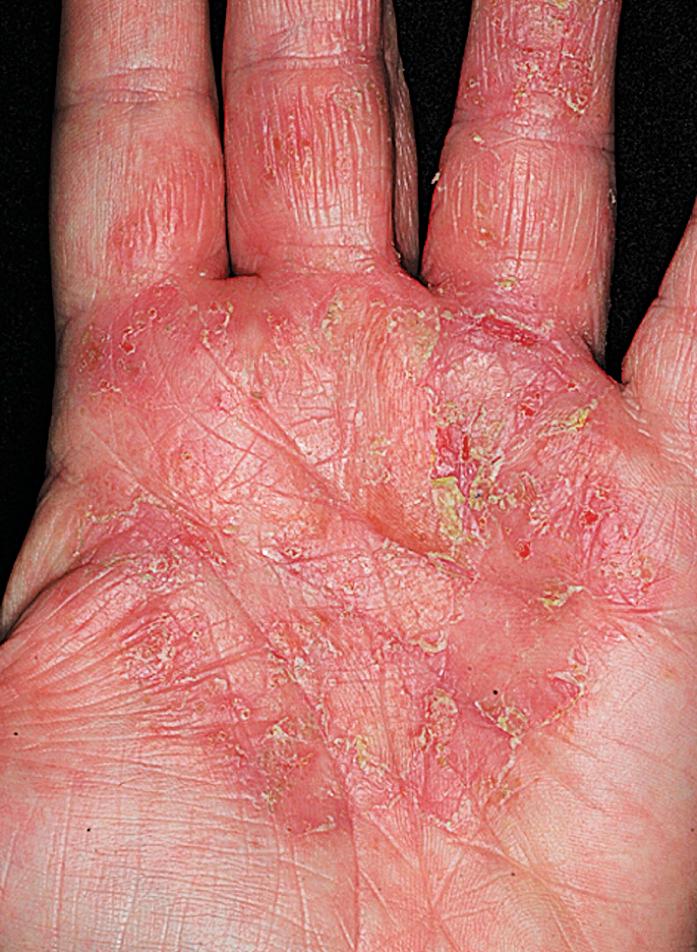
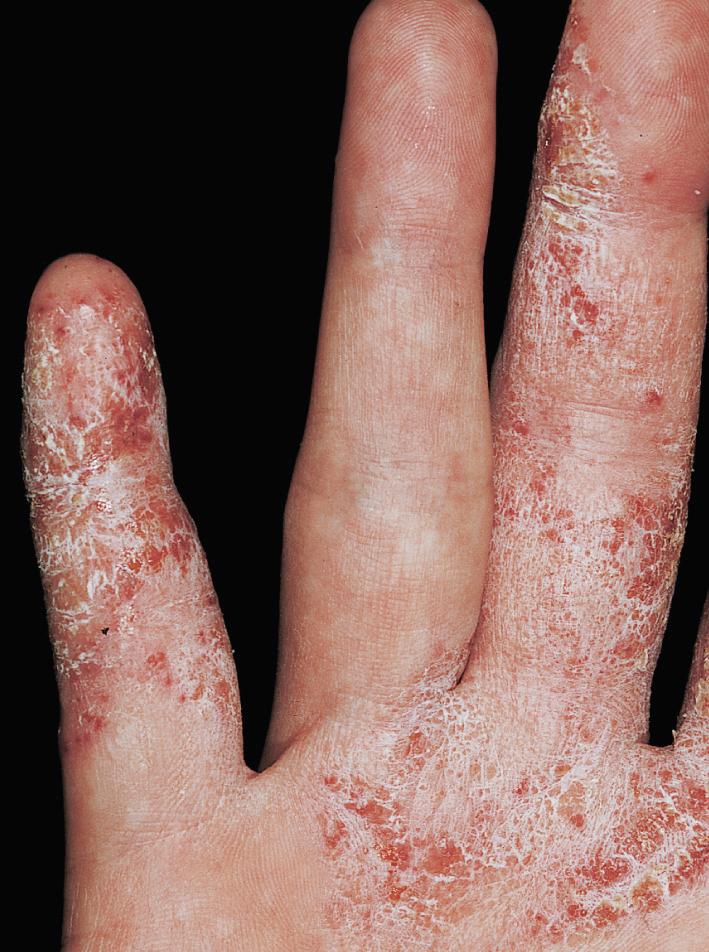
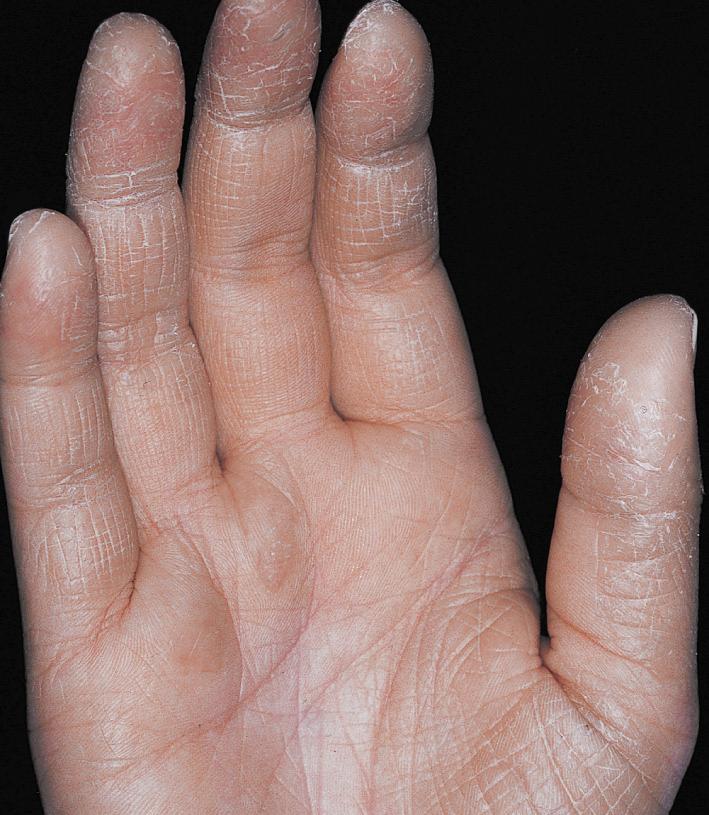
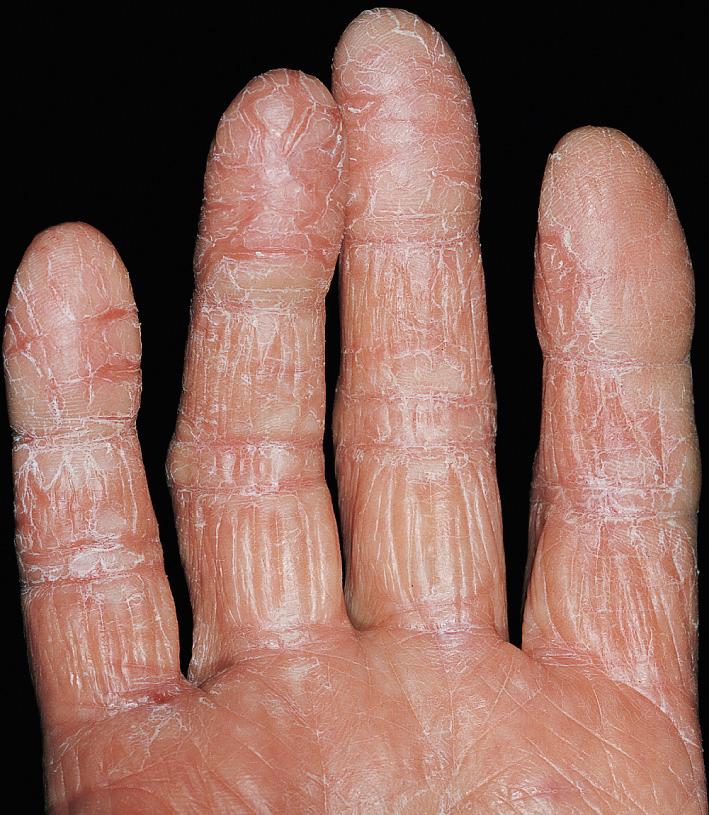
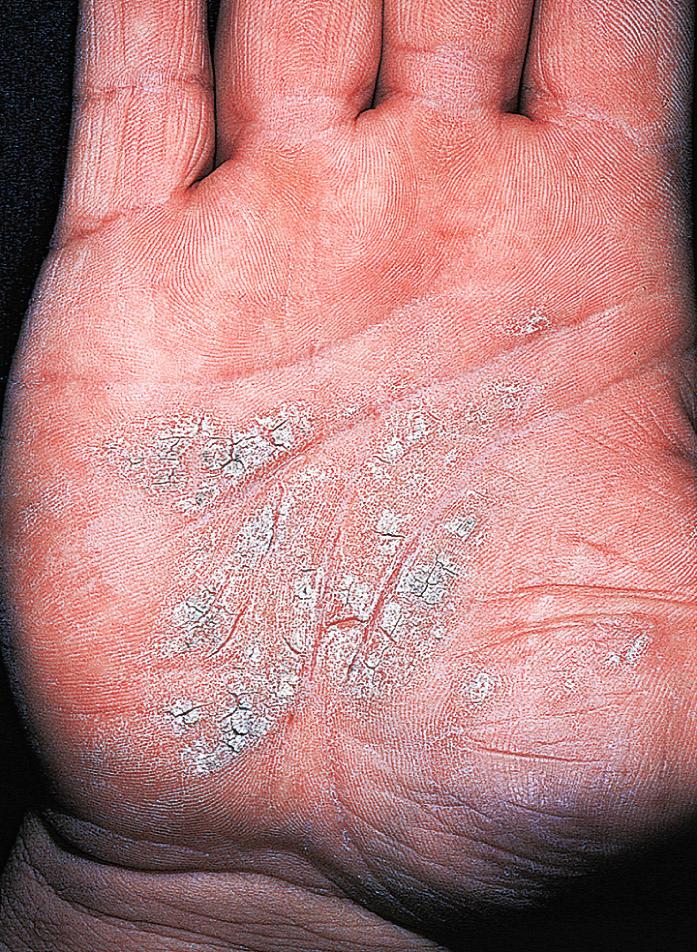
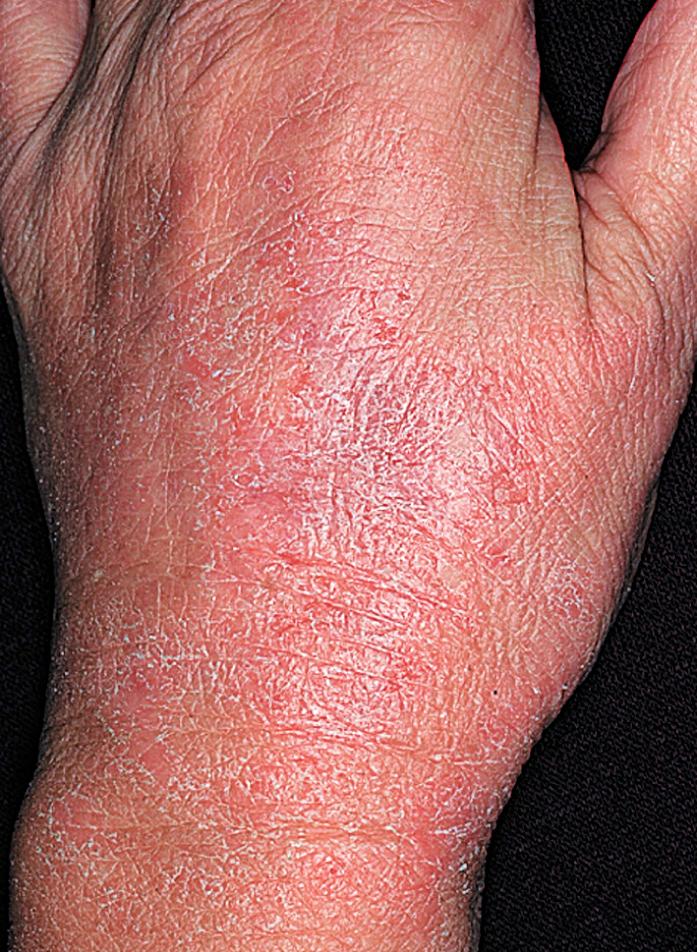
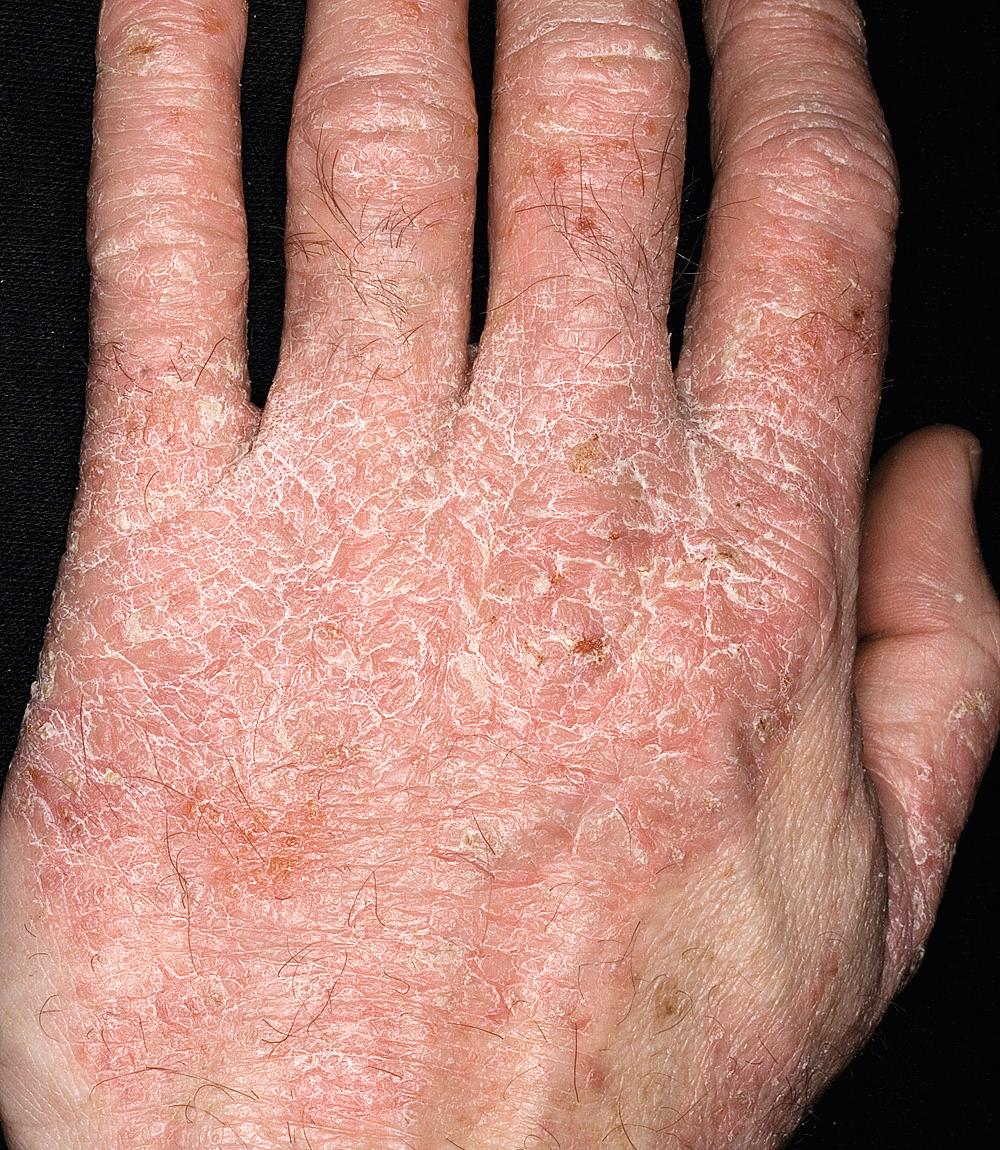
Avoidance and appropriate care often improve the condition, but some patients may not resolve it entirely.
Treatment involves the identification and avoidance of irritants, such as frequent hand washing and water exposure, soaps, detergents, and solvents. Chronic frictional trauma is also an irritant that can result in persistent dermatitis.
Protective measures (e.g., vinyl gloves for wet or chemical work) can be taken.
Topical corticosteroids with medium to high potency (groups II–IV) are administered twice daily. Ointments are preferred to creams. It is preferable to refrain from superpotent (group I) agents unless the dermatitis is severe. Topical steroids for hand dermatitis are most effective when used intermittently, rather than chronic management.
For severe and weeping dermatitis, a superpotent topical corticosteroid is applied after tap-water or Burow's solution wet dressings twice a day for the initial 3 to 5 days of treatment, followed by the application of a medium-potency topical corticosteroid twice a day for several weeks.
The following should be considered: topical tar hand soaks with Balnetar oil, two or three capfuls diluted in a basin of water for 15 to 30 minutes twice a day, followed by the application of topical corticosteroid.
Systemic steroids (prednisone 0.5–1 mg/kg/day with tapering over a 3-week course) may occasionally be required to bring a severe acute inflammation under control.
Most patients improve with avoidance of irritants, treatment with topical corticosteroids, and frequent lubrication.
If allergy is suspected (hand edema, vesiculation, itching, and particularly dorsal hand eczema or recurrent eczema not responding to treatment), patch testing should be done to evaluate for contributing or causal allergens. Relevant occupational allergens should be included in the tested materials.
The patient should be referred to a dermatologist in chronic unresponsive cases. Other treatments that may be considered include topical psoralen−ultraviolet A treatment and Grenz ray therapy. In disabling cases, management with weekly low-dose methotrexate (5–15 mg weekly) or oral low-dose daily cyclosporine (3–4 mg/kg) is reasonable.
Dupilumab should be a consideration for severe, refractory, chronic cases that have otherwise been fully evaluated.
Biopsy may be considered in severe cases.
Chronic, cyclic vesicular hand dermatitis (pompholyx) represents a most difficult management problem.
Patch testing to occupational and environmental allergens should be considered if hand eczema does not improve or resolve with simple measures. A broad screening series including other potential allergen trays depending on history of exposure should be tested for the greatest yield. Occupation-specific trays (i.e., hairdressers, machinists) may be important.
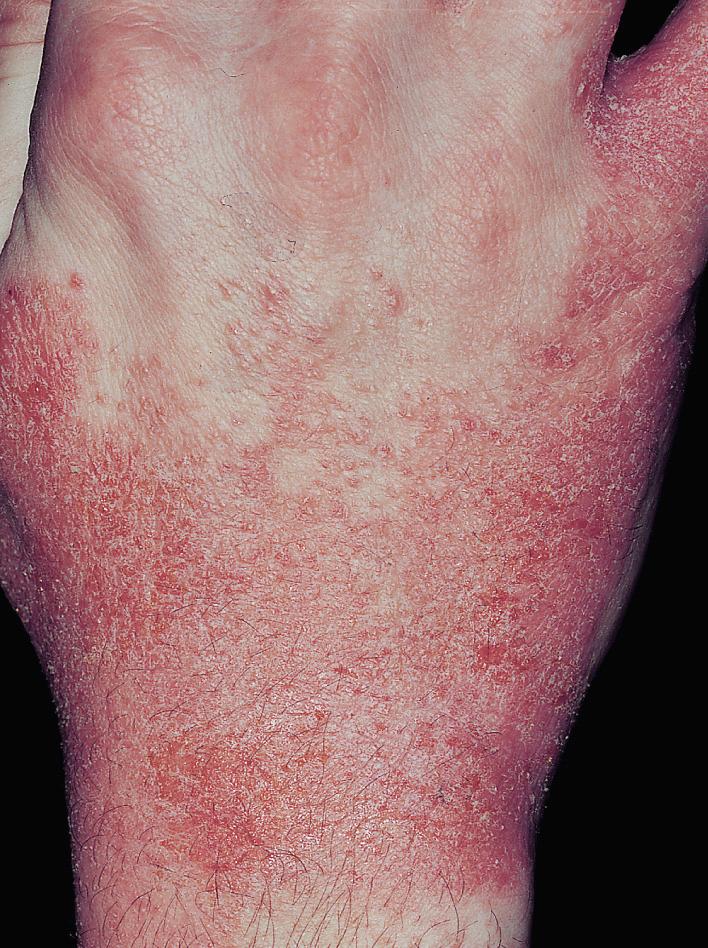
Referral to a dermatologist for evaluation and patch testing is warranted when hand eczema does not resolve after a trial of sensitive skin care, including daily emollient use, protective use of gloves for frequent wet or chemical work, and a few weeks' course of topical steroid treatment.
Psoriasis on the palms can mimic eczema. If there is sharp demarcation of plaques on the palms, with silvery or yellowish chronic scaling and symmetric involvement, a diagnosis of palmar psoriasis should be considered.
Causal or contributing factors to hand eczema are not well identified unless the clinician seeks to know how and what the hands are exposed to: the occupation, household duties, hobbies, and hand care should be explored in detail. Although new routines or exposures can lead to a new case of hand eczema, chronic exposures may also lead to allergy. More than one relevant allergen is often identified in cases of chronic hand eczema.
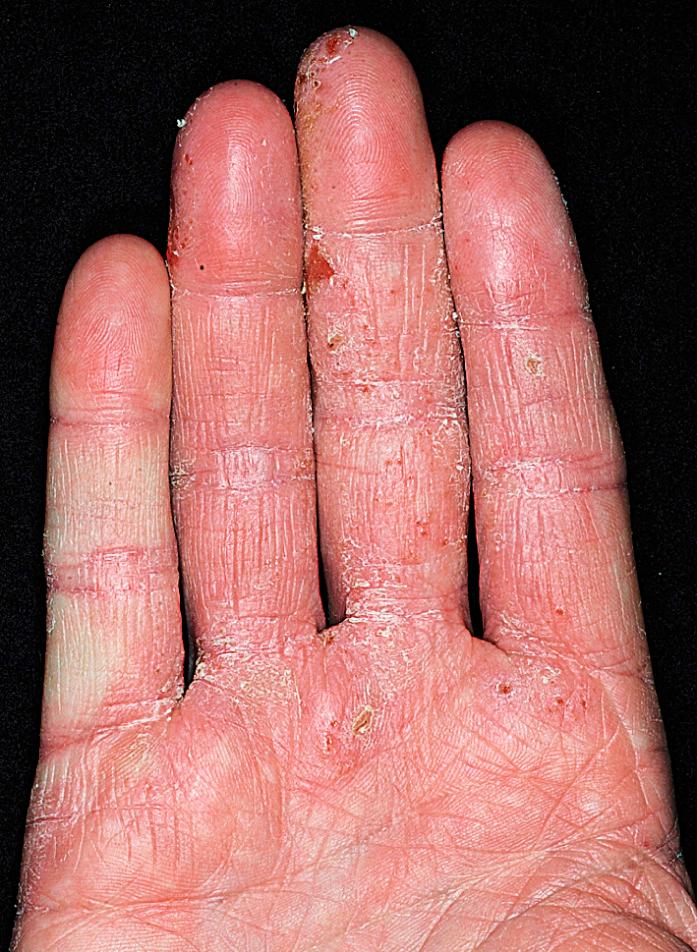
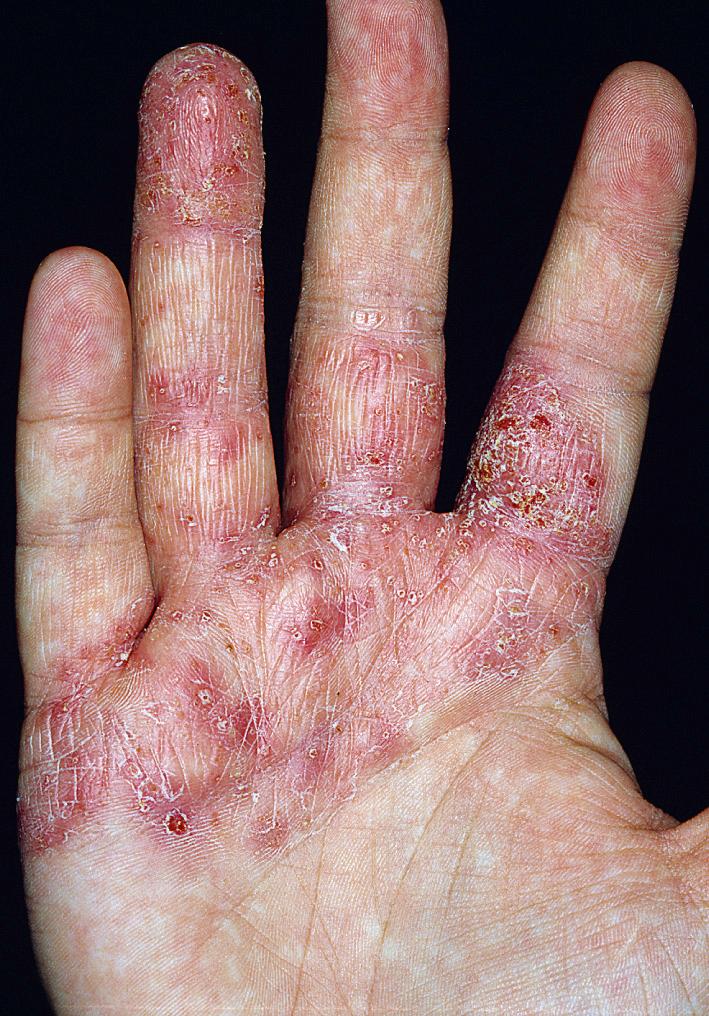
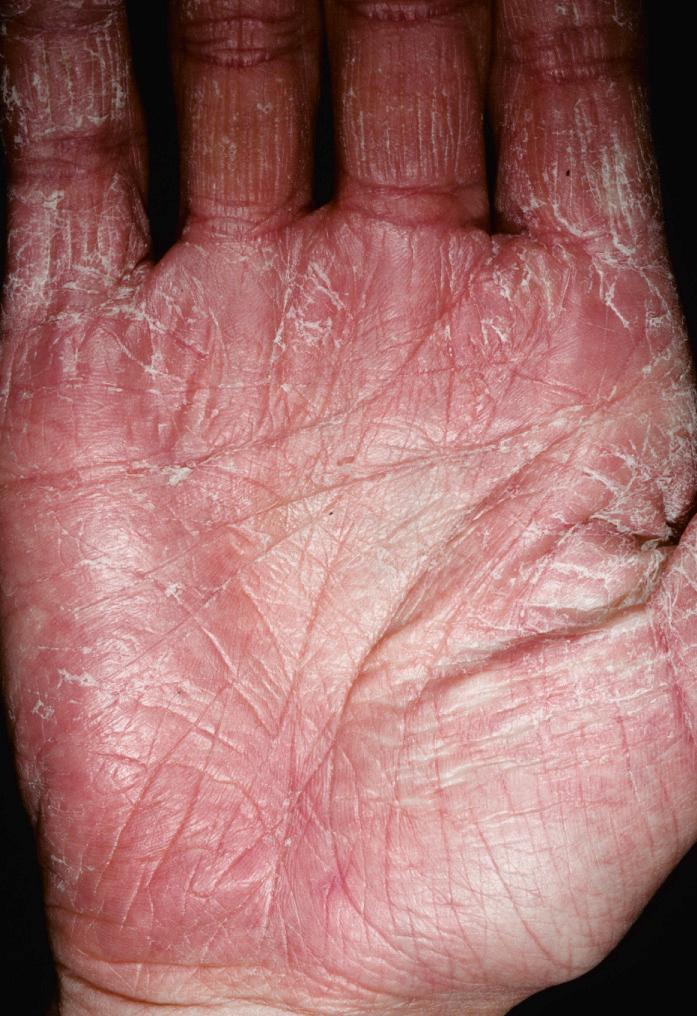
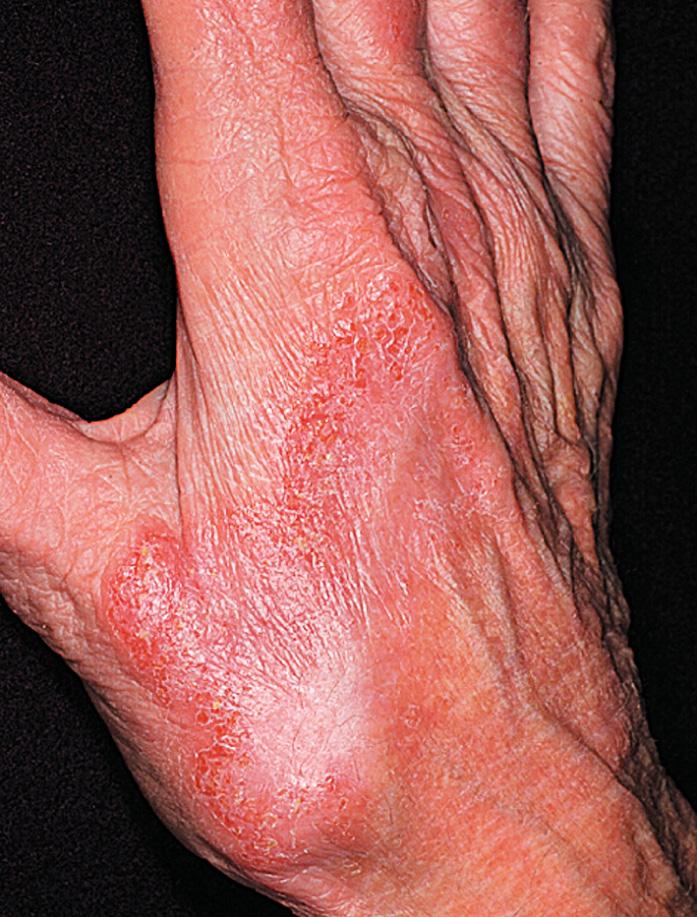
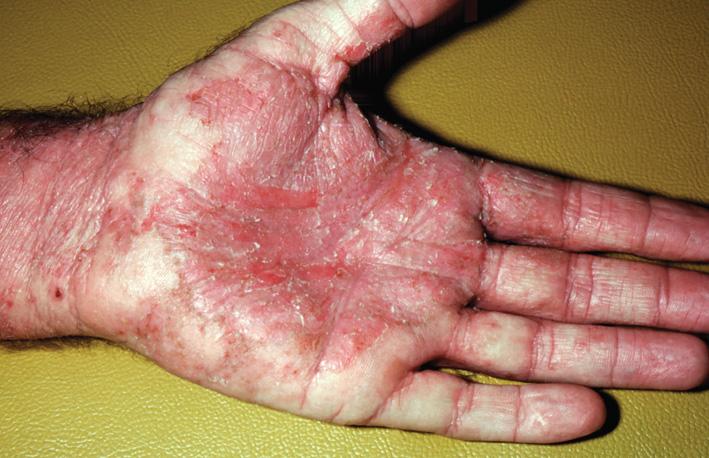
| Allergens | Sources |
|---|---|
| Nickel | Door knobs, handles on kitchen utensils, scissors, knitting needles, industrial equipment, hairdressing equipment |
| Potassium dichromate | Cement, leather articles (gloves), industrial machines, oils |
| Rubber | Gloves, industrial equipment (hoses, belts, cables) |
| Fragrances | Cosmetics, soaps, lubricants, topical medications |
| Formaldehyde | Wash-and-wear fabrics, paper, cosmetics, embalming fluid |
| Lanolin | Topical lubricants and medications, cosmetics |
| Preservatives | Cosmetics, moisturizing creams and lotions, wet wipes, cooling fluids |
A distinctive clinical pattern of eczematous dermatitis that is caused by excessive dryness and chapping of the skin. This is also referred to as eczema craquelé .
Asteatotic eczema is a form of subacute eczematous dermatitis that tends to be chronic and low grade with wintertime seasonal flares because of low humidity.
Men and women are equally affected. It is more common in elderly people.
It is more common in patients with the atopic diathesis (see later section, Atopic Dermatitis), especially in later life.
Most patients have a history of previous similar flares.
The prevalence peaks in late winter and improves in summer, especially in colder, drier climates.
Any cutaneous site may be affected, although the lower legs are most commonly involved.
Early on, affected individuals often note that their skin looks and feels dry.
With progression, itch, with increasing inflammation, becomes the most prominent symptom.
Burning and stinging occur in advanced cases with fissures and crusting.
The clinical picture is that of subacute eczematous dermatitis.
Xerosis with accentuated skin markings is a constant feature from the onset.
Inflammation is at first subtle but becomes more pronounced over time.
Faint, poorly defined erythema progresses to fiery red, acute eczematous papules that coalesce into broad plaques.
Vesicles are not typically seen, although excoriations are nearly universal.
Dry, thin desquamation progresses toward the pattern of eczema craquelé, with thin superficial fissures reminiscent of the cracked finish on porcelain or of a dried riverbed.
The skin is very dry, cracked, and fissured. The skin may be painful.
With progression, the eczema develops acute features with weeping, crusting, and intense erythema.
Fever is unusual and suggests cellulitis.
The clinical picture is distinctive enough that skin biopsy is rarely needed to establish the diagnosis.
Skin biopsy confirms epidermal spongiosis with a superficial perivascular infiltrate and often with secondary impetiginization.
Seasonal recurrence during the winter months should be expected.
Mild seasonal flares with itching and xerosis tend to improve with warmer weather, seasonal change, and repetitive skin lubrication with a bland moisturizer, cream, or ointment (preferred over lotion).
Active subacute inflammation generally responds to topical medium-potency corticosteroid ointments and also improves with the season.
A severe localized flare with acute features, such as weeping and crusting, also responds to individualized topical therapy, as outlined later.
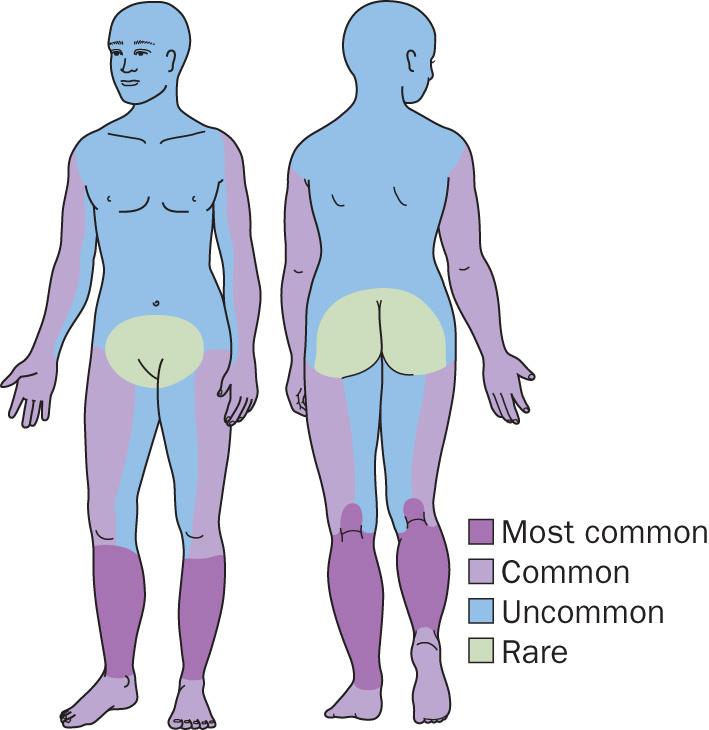
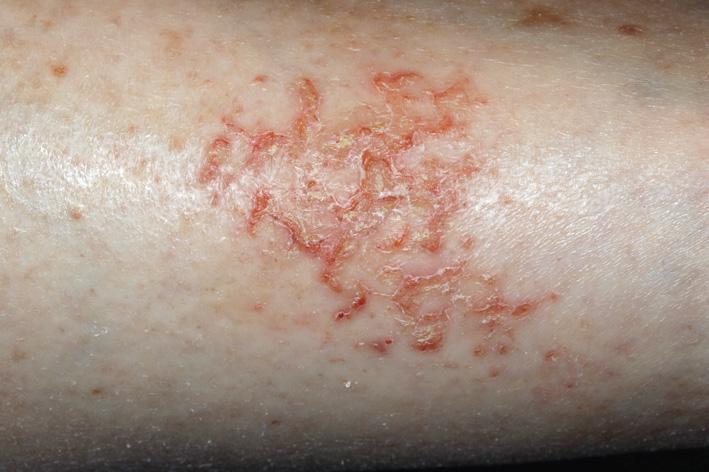
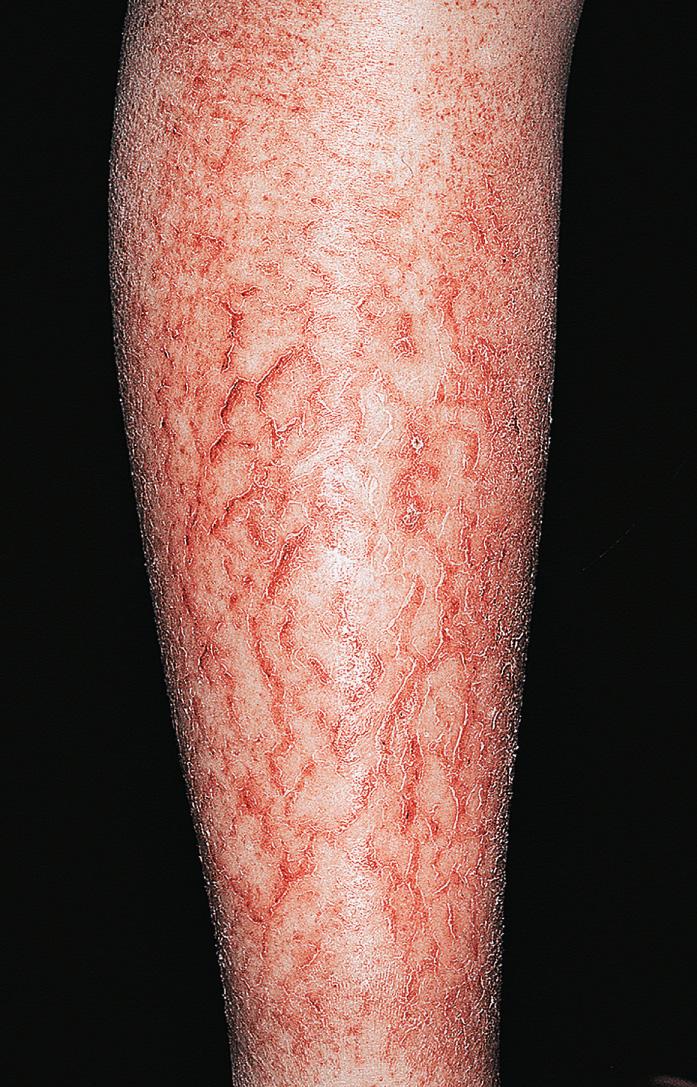
The differential diagnosis includes other subacute eczematous dermatoses, such as stasis dermatitis, irritant contact dermatitis, atopic dermatitis, allergic contact dermatitis, and less likely, cellulitis.
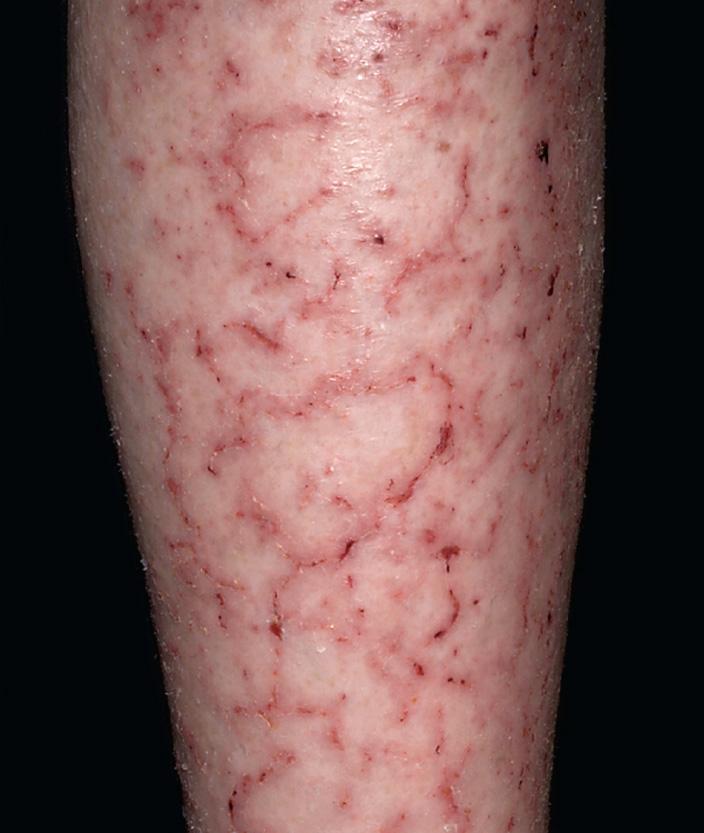
More than one dermatosis may be present. The second dermatosis may mask or exacerbate the primary eczematous process.
Irritant and allergic contact dermatitis may develop as a result of the patient's own efforts at self-treatment.
Patients should be asked about what they have been applying to the involved areas.
Stasis dermatitis occurs, commonly on the lower legs, in older patients. There is usually a history of vascular insufficiency and leg edema and the presence of hemosiderin staining of the skin.
Therapy is determined by the stage (acute, subacute, or chronic) of the asteatotic eczema and the degree of inflammation.
For xerosis, therapy consists of sensitive skin measures, namely the limited use of mild soap and the liberal use of emollients.
Petrolatum offers a preservative-free choice as a lubricant, although patient compliance may be difficult.
Moisturizers containing lactic acid, urea, or glycolic acid may also be useful.
Early inflammation is best treated topically with a medium-potency corticosteroid, preferably in an ointment base.
Therapy should be continued until the erythema and scaling resolve.
Liberal use of emollients should then be continued as a prophylaxis against recurrence. Bland, fragrance-free emollients are best (Vanicream, Aveeno, CeraVe, Cetaphil).
Localized flares with acute eczematous features of weeping and crusting should be treated first as acute eczema.
Patients require close follow-up during this stage because localized flares may become generalized.
Referral to a dermatologist should be considered for the management of recurring acute flares and an evaluation for possible allergic contact dermatitis.
Wet dressings with tap water or Burow's solution, along with a medium-potency topical corticosteroid in a cream base, are helpful for débridement and reducing inflammation.
Oral antibiotics may be indicated for secondary impetiginization, indicated by honey-colored, sticky crusts.
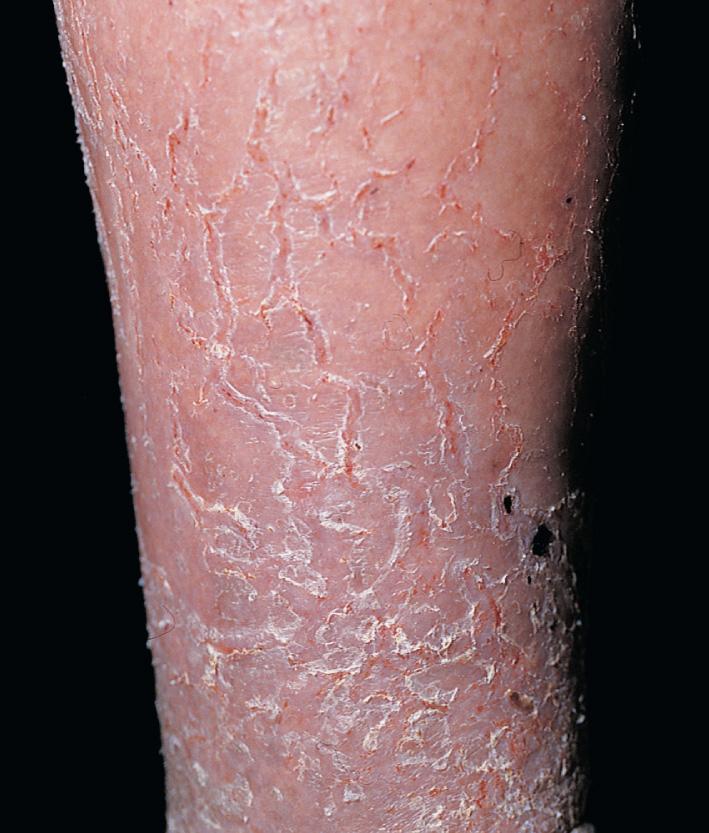
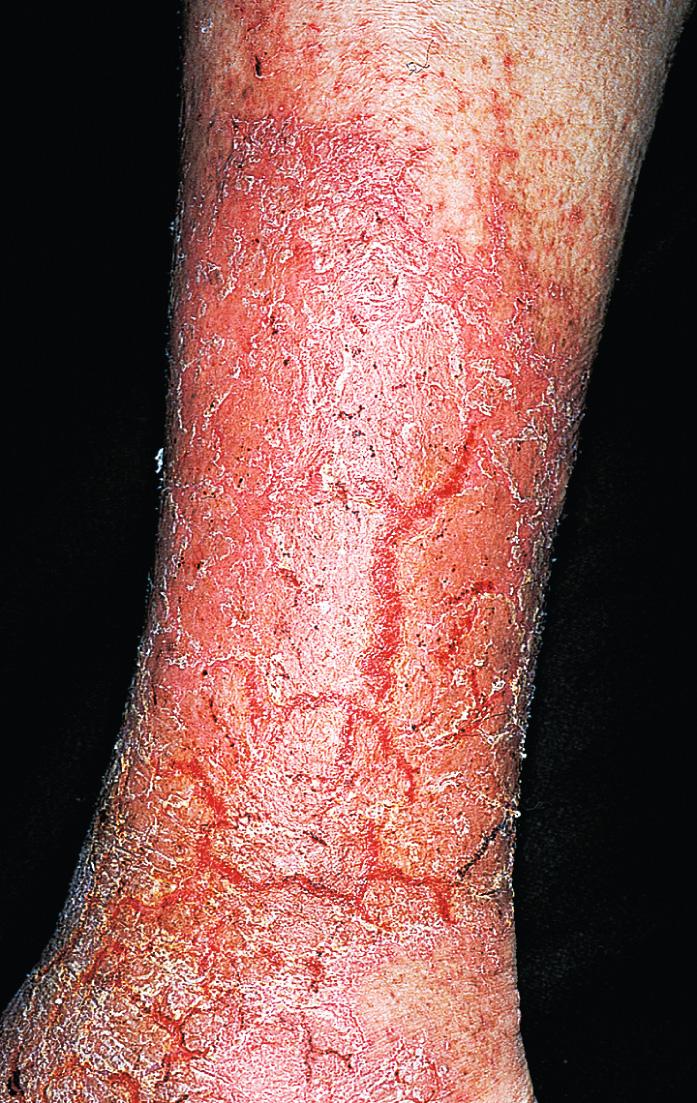
After the weeping, induration, and crusting improve, the wet dressings should be stopped to avoid excessive drying of the involved areas.
A medium-potency topical corticosteroid ointment (group II or IV) should be continued until the redness and scaling resolve, about 2 to 3 weeks.
Thereafter, sensitive skin care, including emollients, is helpful in limiting recurrence.
Systemic steroid therapy is rarely indicated for asteatotic eczema.
Become a Clinical Tree membership for Full access and enjoy Unlimited articles
If you are a member. Log in here